Refresh
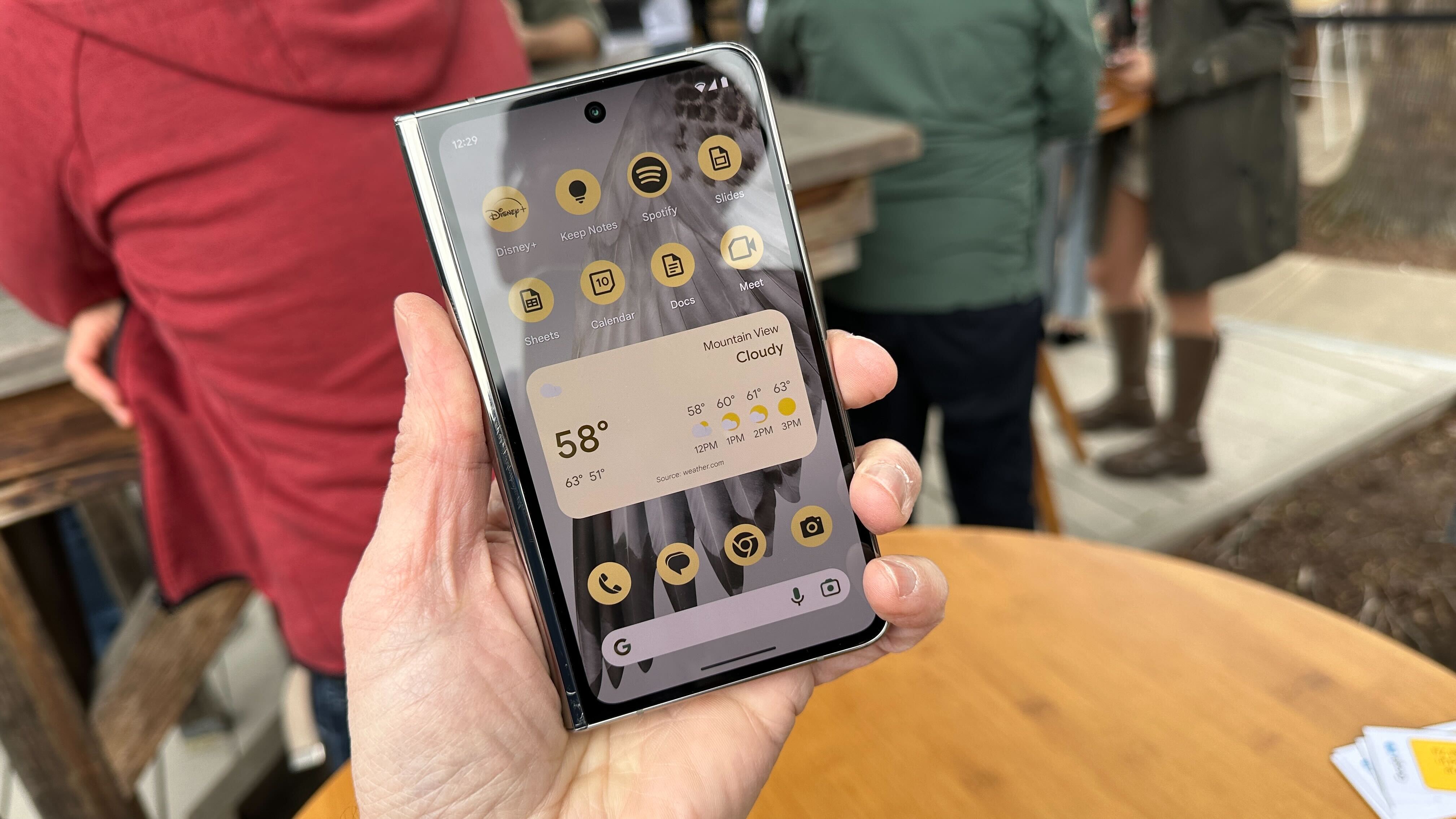
Hands-on with the Google Pixel Fold
Our Chief Lance Ulanoff is on the scene with the Google Pixel Fold, giving us our first hands-on impressions of the foldable that could change all foldables.
Lance tells us that the Pixel Fold is small, thin, cute, and a bit disappointing. The border is massive, compared to the Galaxy Z fold 4 and they really have not solved the crease problem.
Is it possible that Google overpromised when they talked up the Pixel Fold at the Keynote? We’ll have Lance’s full hands-on look in just a bit.
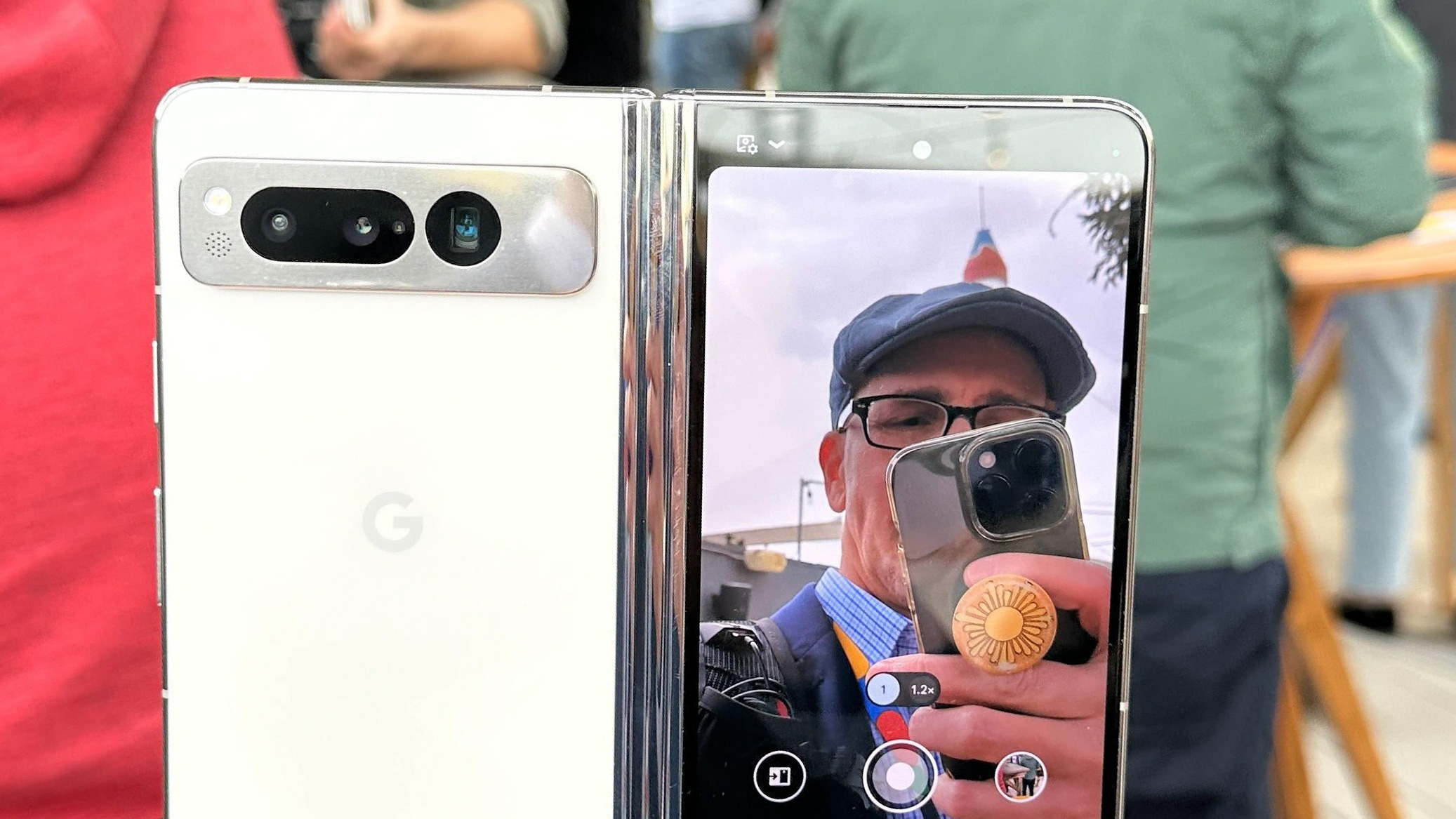
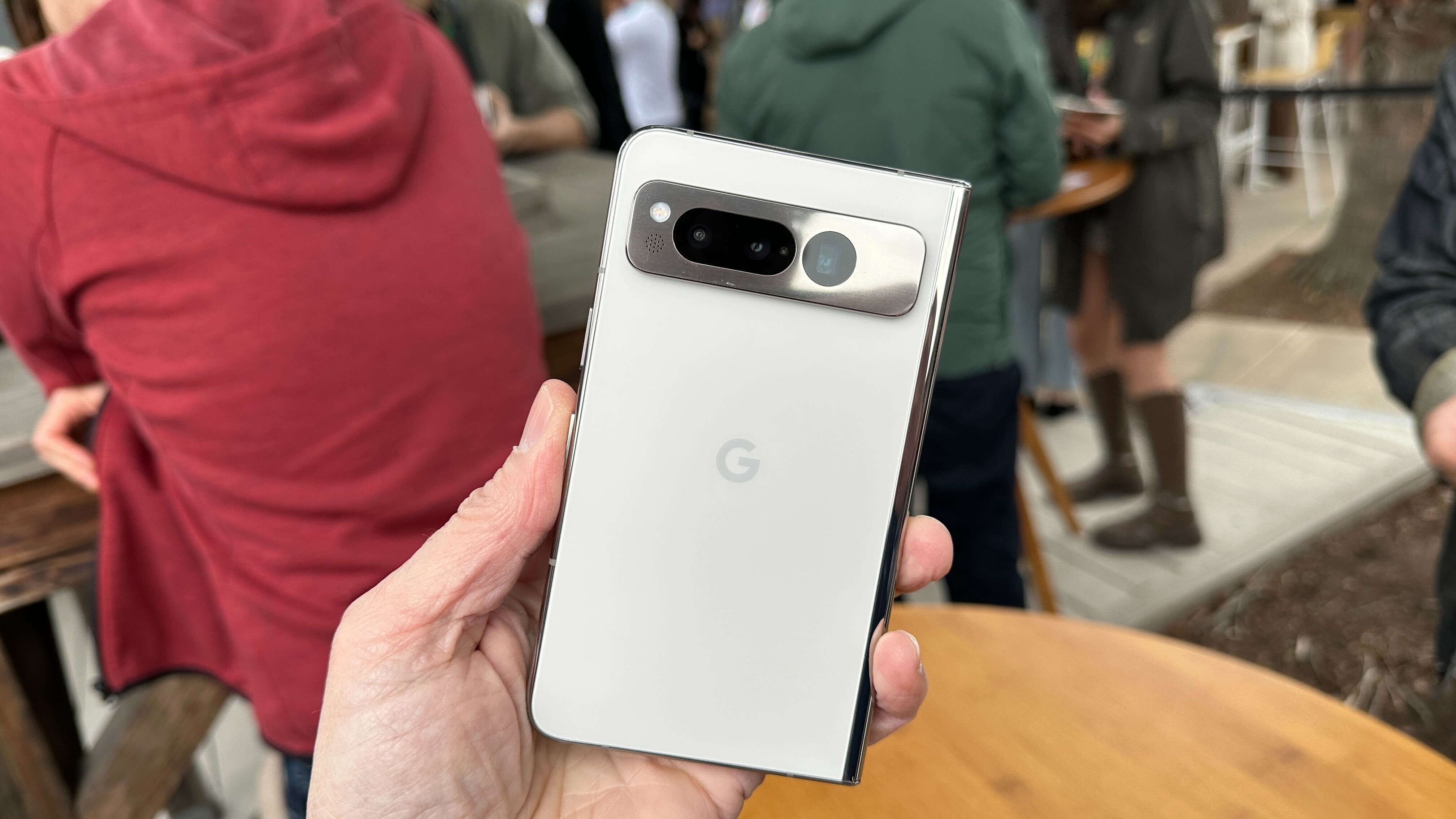
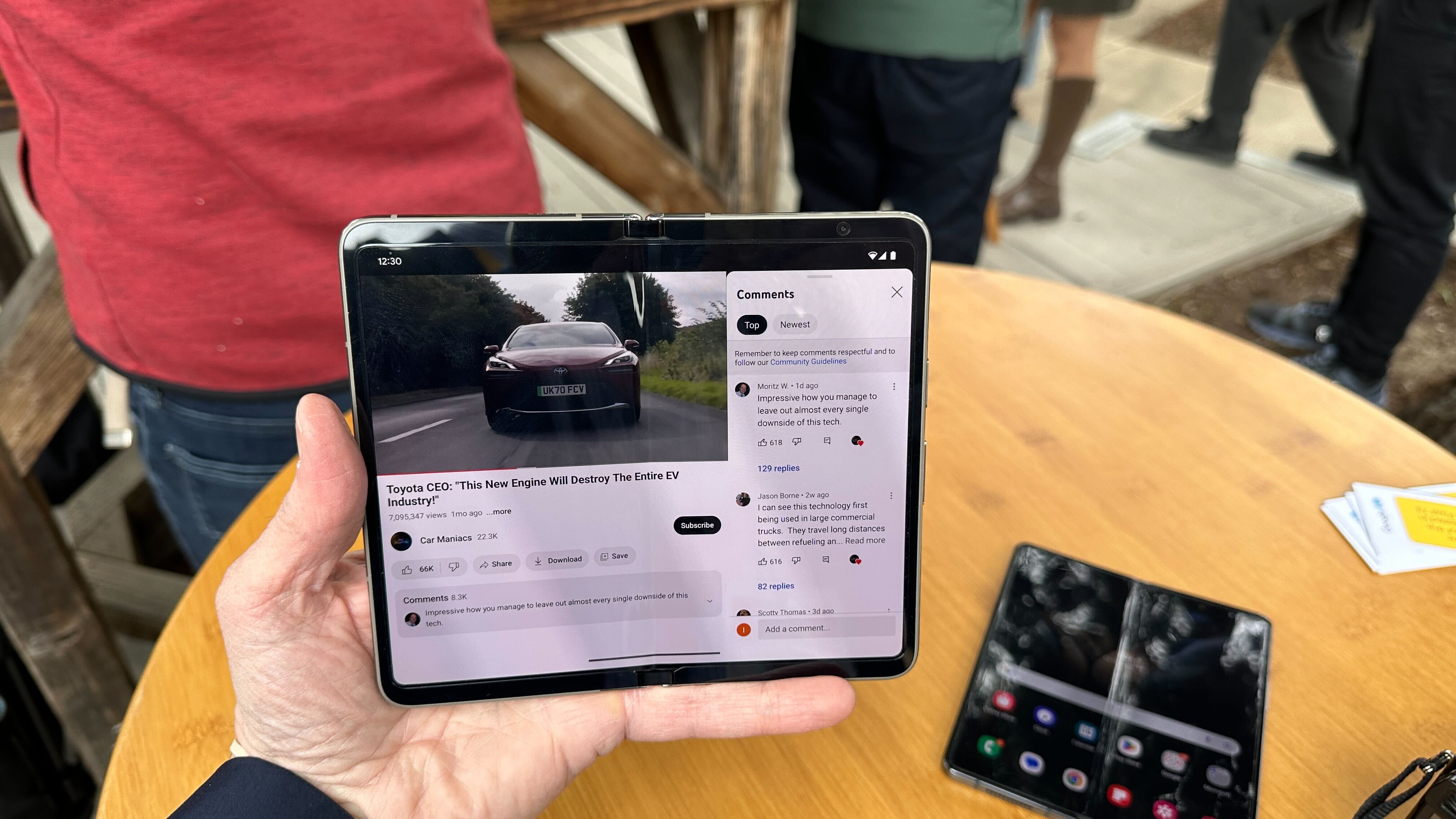
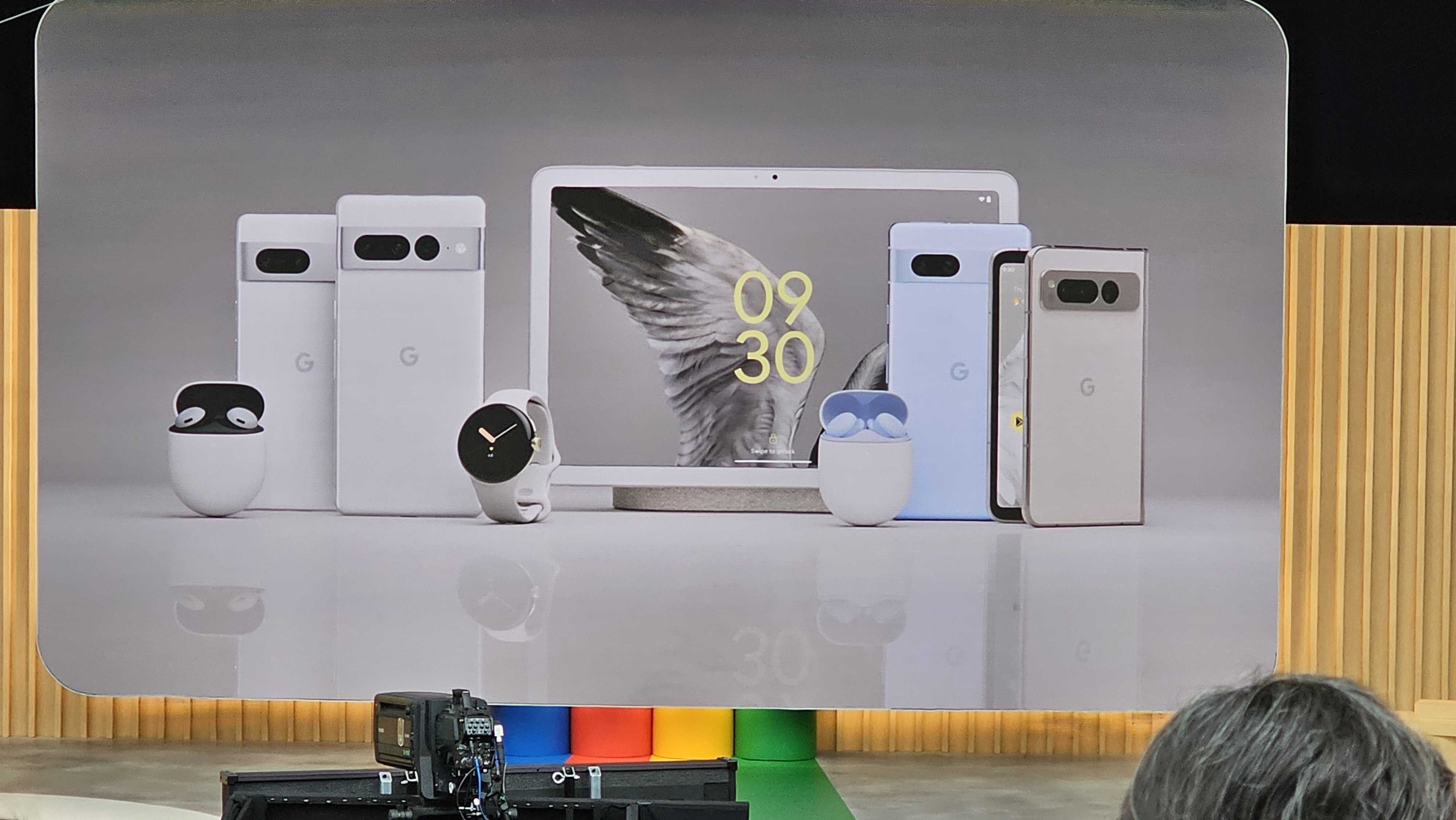
Pixel Fold pre-orders start today with a free Pixel Watch
Google is taking Pixel Fold pre-orders immediately, and if you buy one now you can get a Pixel Watch for free. Admittedly, that’s not a huge discount on a phone that costs so much, but everybody loves a good bundle.
Google did not say when the phone will ship, but it should be some time next month. The Pixel 7a is available immediately, so you can rush to buy one if you please, though I’d suggest reading my Pixel 7a review first.
Our editors are grabbing hands-on time with the new devices, and we’ll have more news and impressions coming soon. The Live Blog continues even though the keynote is over, because the Google show has just begun!
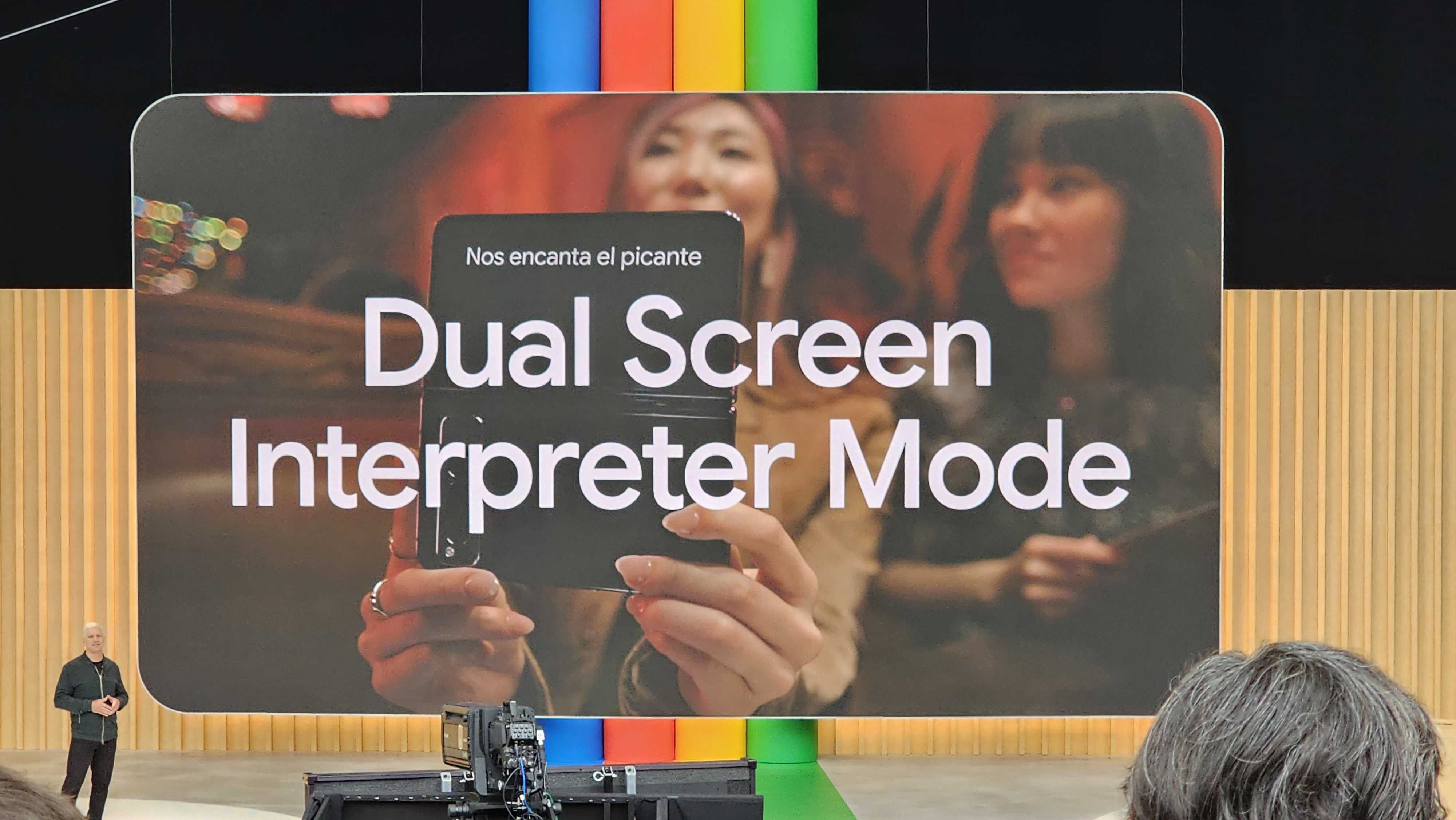
Tablets aren’t the only big screen device today – here’s Pixel Fold
After teasing the Pixel Fold on May the Fourth, Google has finally taken the wraps off of the Pixel Fold. Without shame, Osterloh has announced this as a $1799 device. Leading with the price tag is a bold move for a phone that costs more than mosts laptop computers, but it’s not inappropriate. Oh, it also has features, but you’ll notice the price tag first.
Among the standout features we’re seeing first, the Pixel Fold has a dual-screen interpreter mode. You hold the phone up to your foreign speaker while you talk, and you both will get to see a written translation of what you’re saying. This is very similar to the AR translation tech we have been hoping to hear more about.
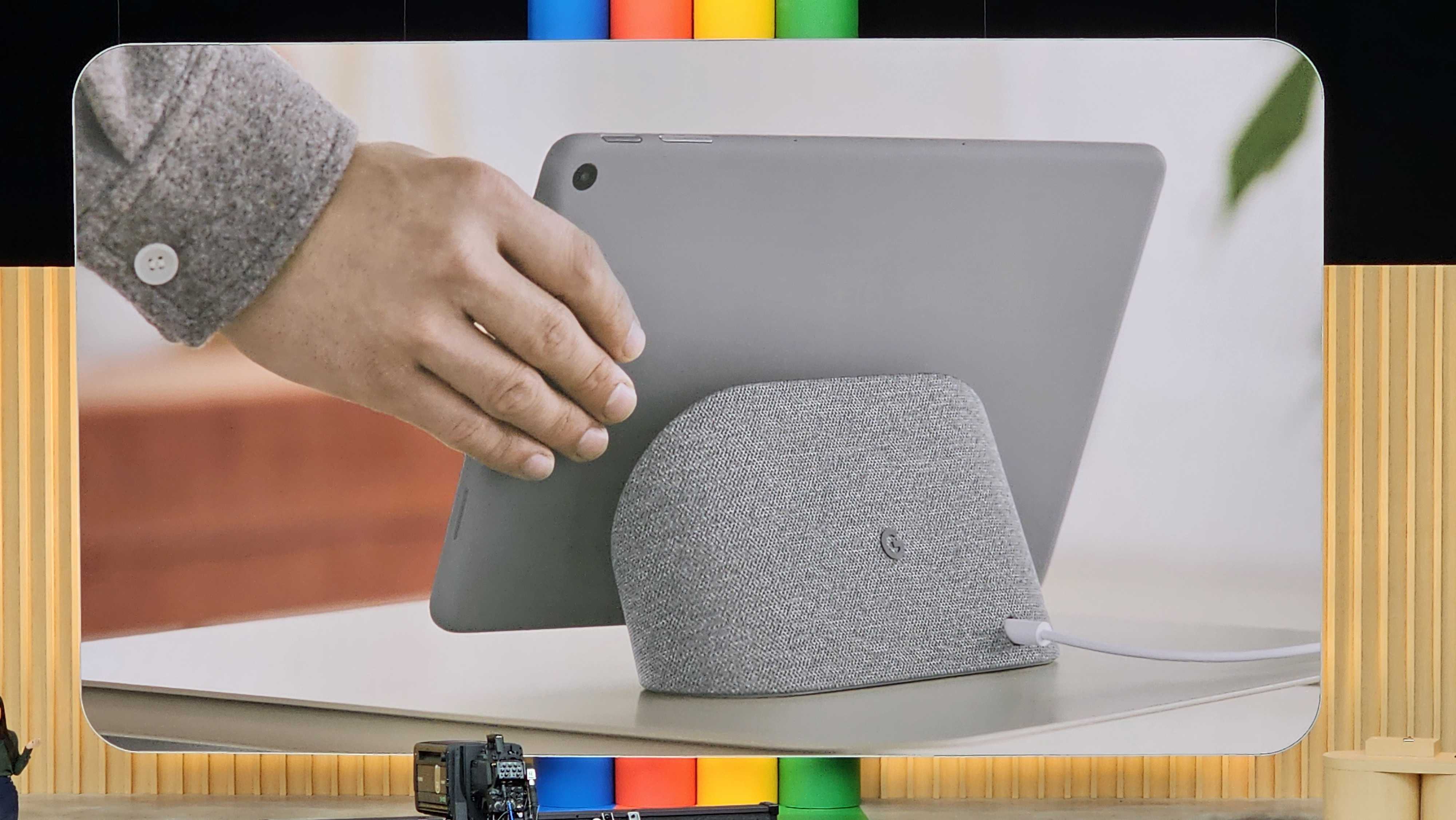
Google finally gives us the promised Pixel Tablet
After a year of waiting, Google is finally launching its tablet, the homebody Pixel Tablet. Google is clearly aiming the Pixel Tablet as a home-use device, including a speaker dock that turns it into a smart home controller and digital photo frame.
By unlocking the smart home screen with the fingerprint scanner, the Pixel Tablet opens up its Android system and acts like a normal tablet. When the Tablet is docked, there is a home panel so that anyone can adjust lights or the other smart devices you have controlling your home.
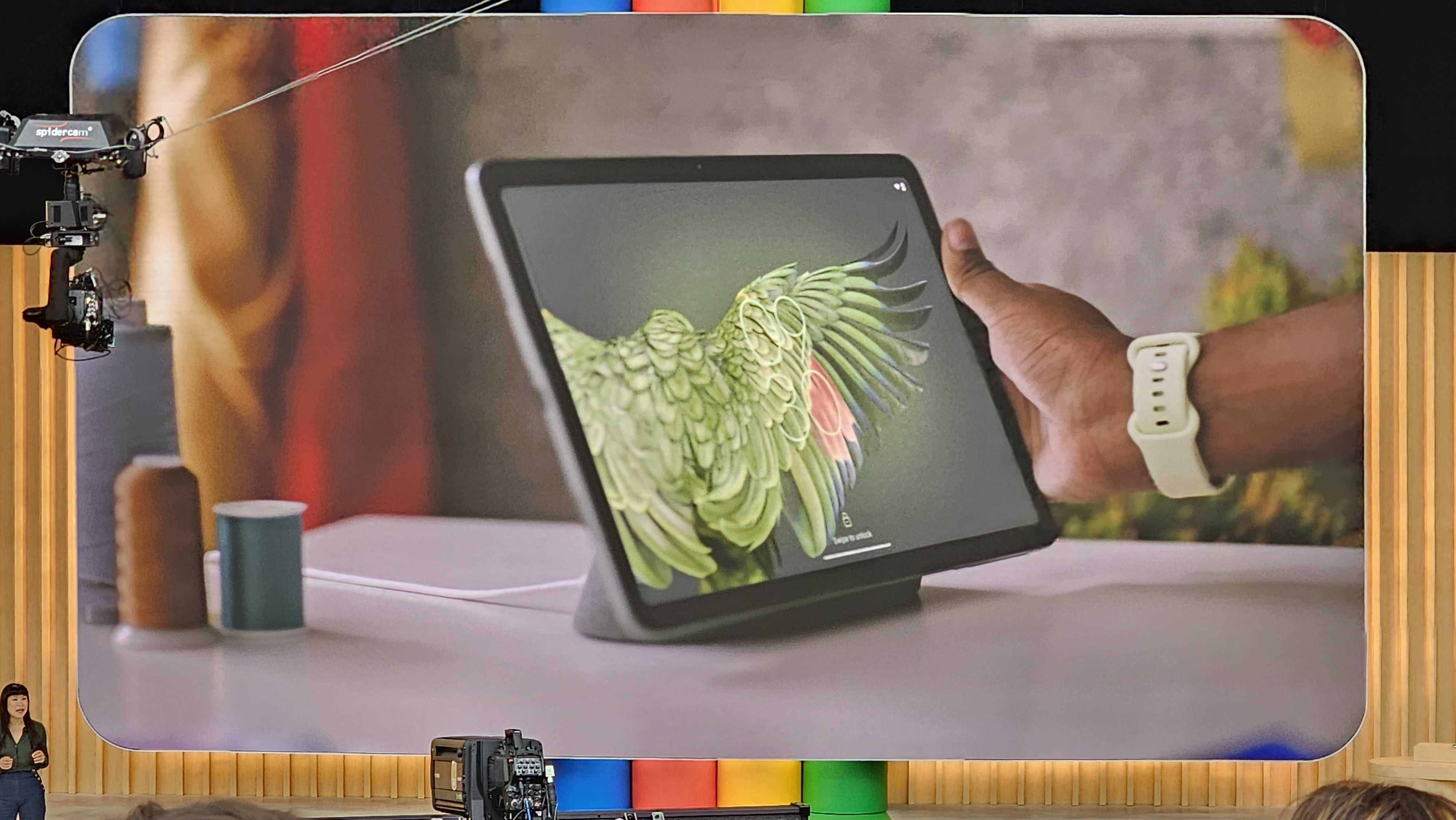
The Pixel Tablet also includes multi-user modes, which is a shocking rarity on tablets. Apple’s iPad does not make multi-user use easy, but the Pixel Tablet gives everyone their own account space.
The Pixel Tablet also has a Chromecast built-in, so you can connect it directly to a TV for all of the Chromecast features you’d get from a dongle.
You can order one today, though they won’t ship until June, 2023. It costs only $499 in the US, including the speaker dock, which is a very competitive price for Google’s big first splash into the modern tablet pool.
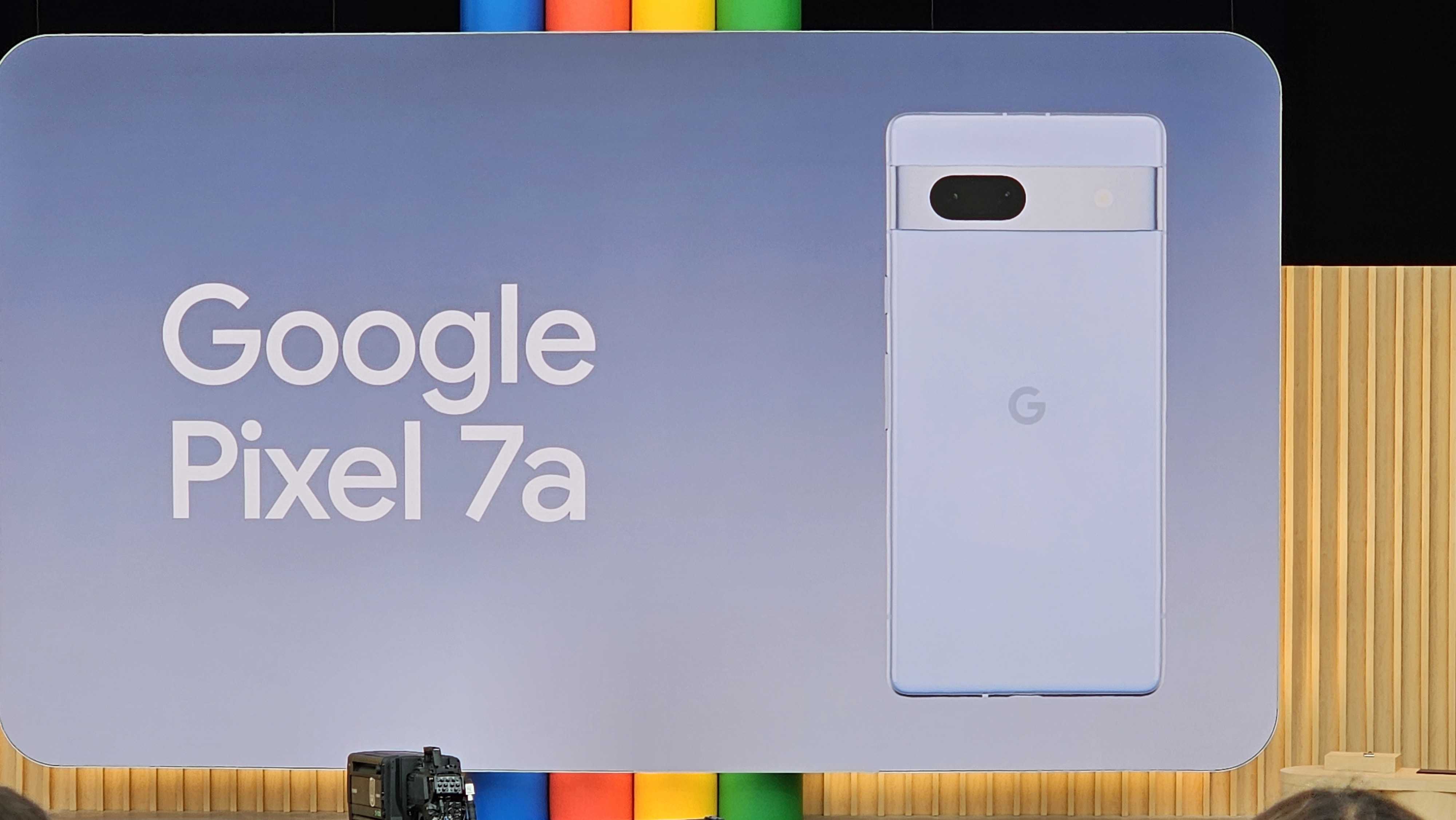
The Google Pixel 7a is here
Google has announced its Pixel 7a, which SVP of Devices Rick Osterloh says is upgraded in every way over the Pixel 6a. The phone is available today for $499 in the US market (UK and AU pricing to come asap).
The phone comes in white, grey, blue and coral, but that coral color is only available directly from Google. The company isn’t saying much about the new phone right now, but we’ll have our full review up as soon as the keynote is done.
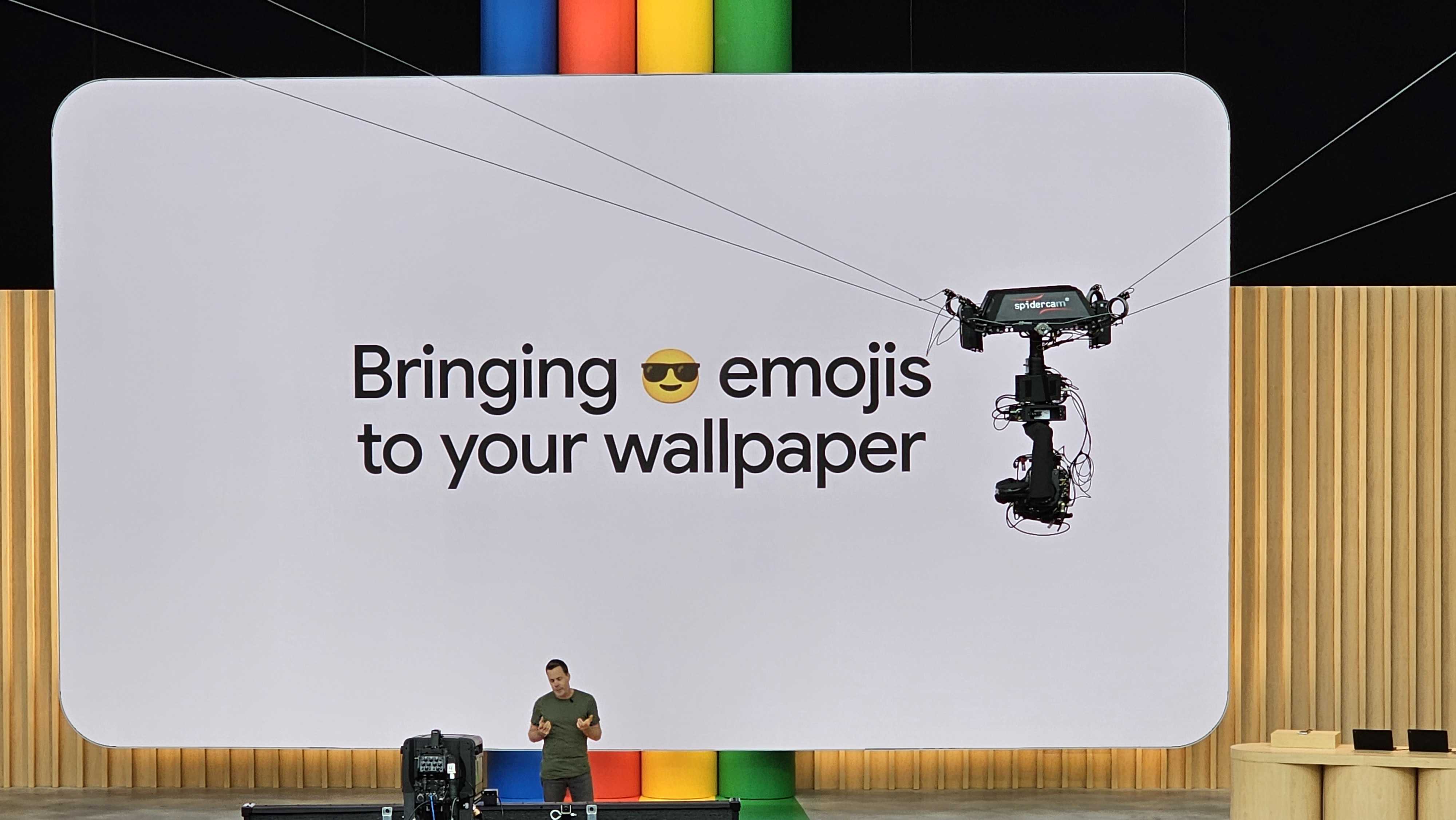
Everything AI, including the wallpaper
We’re about to see the Pixel hardware, finally, but here are some of the AI improvements coming to Android, especially in creating new generative wallpapers. Of course, you could just make the image yourself and then apply it as wallpaper, but the phone will work its magic for you.
Enjoy, and then we’ll get to see the new phones and tablet.
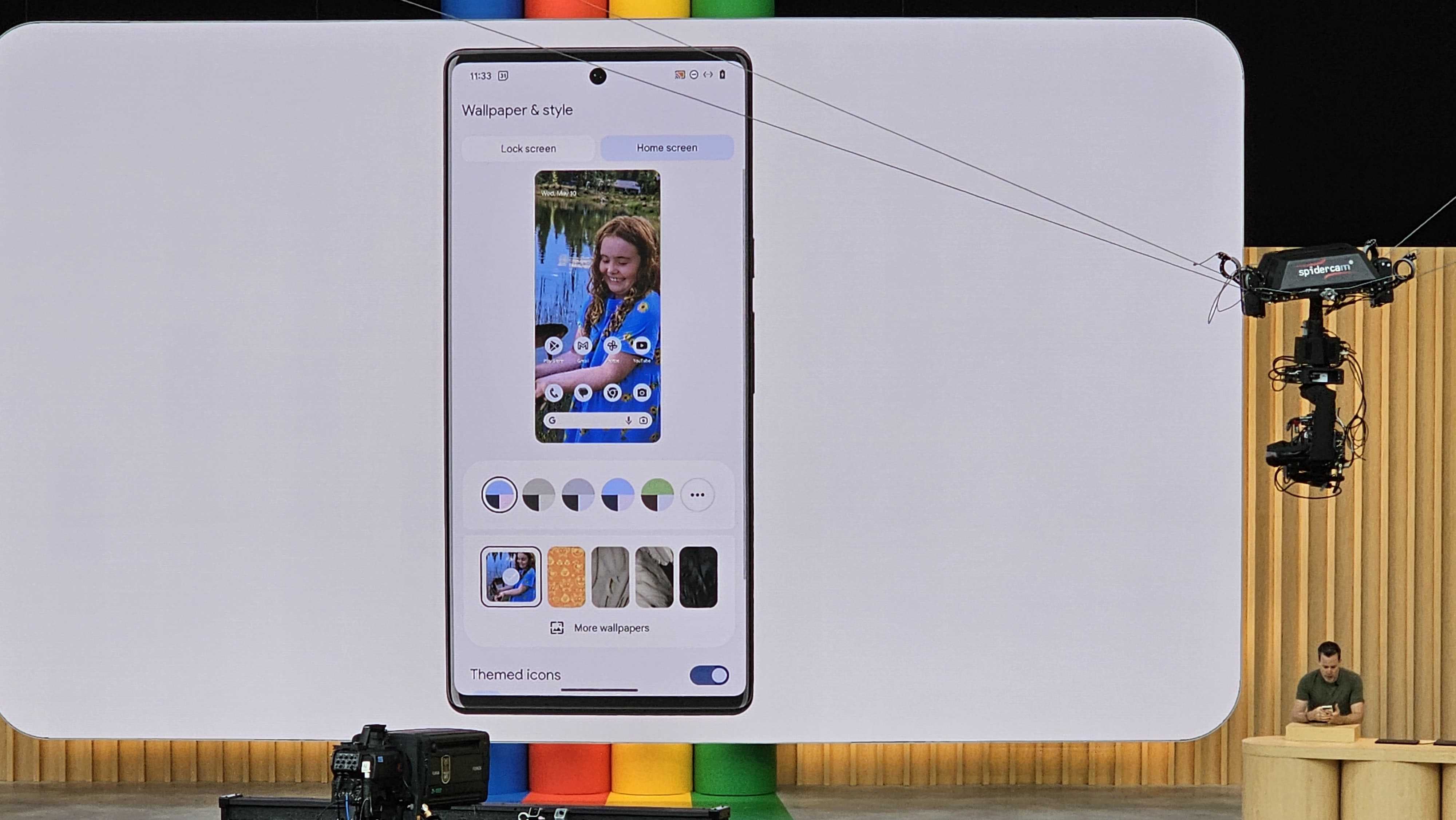
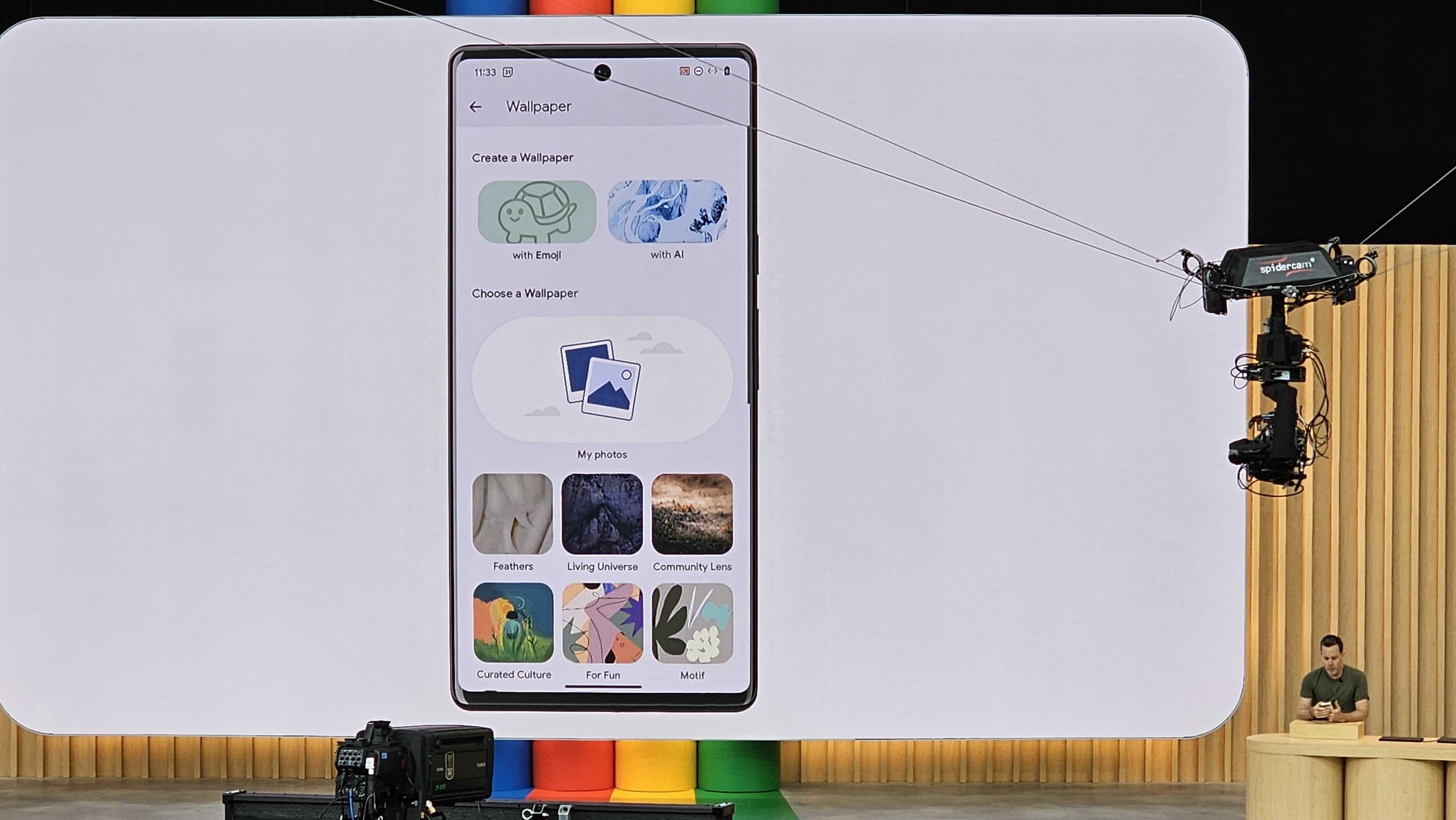
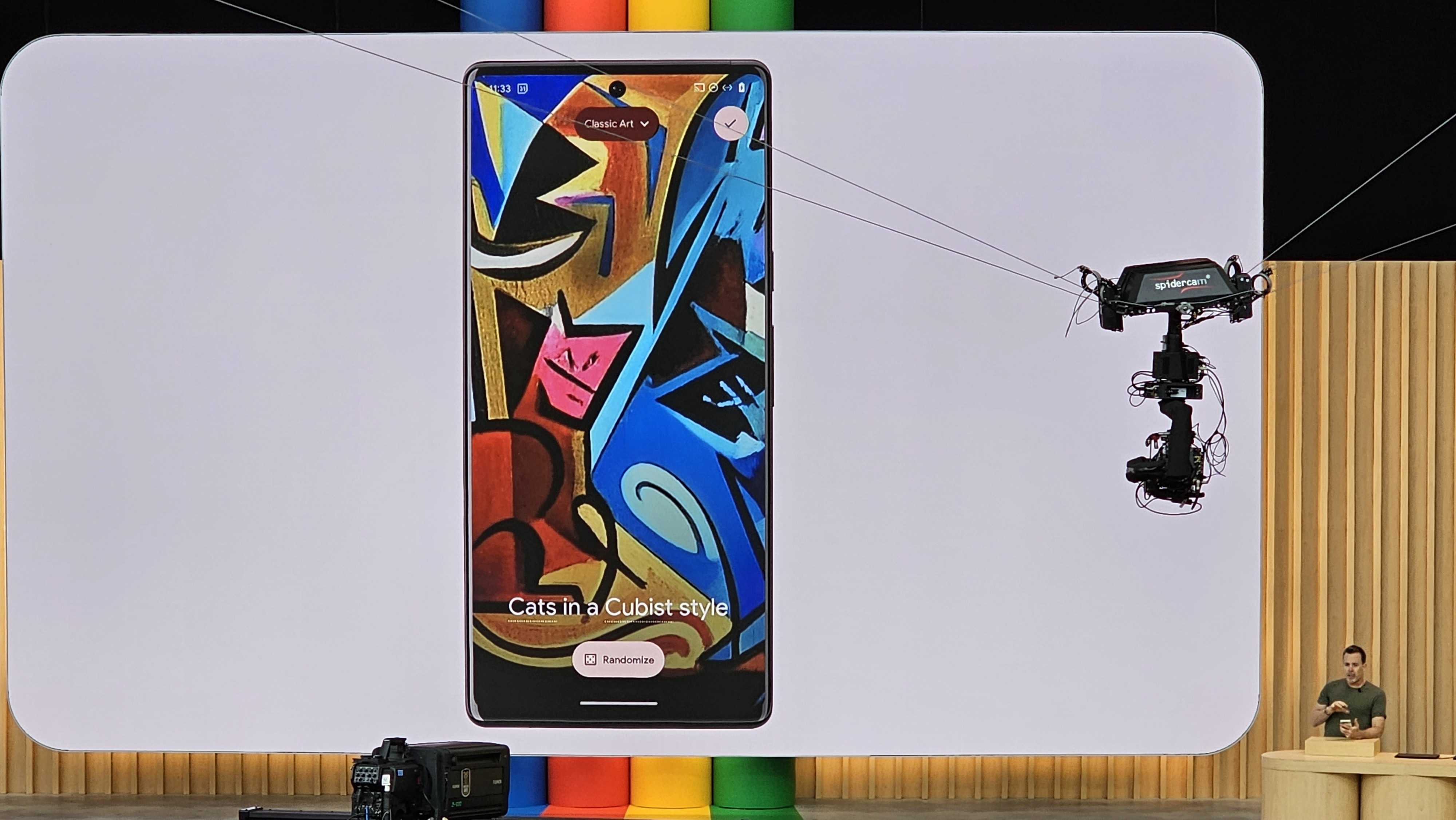
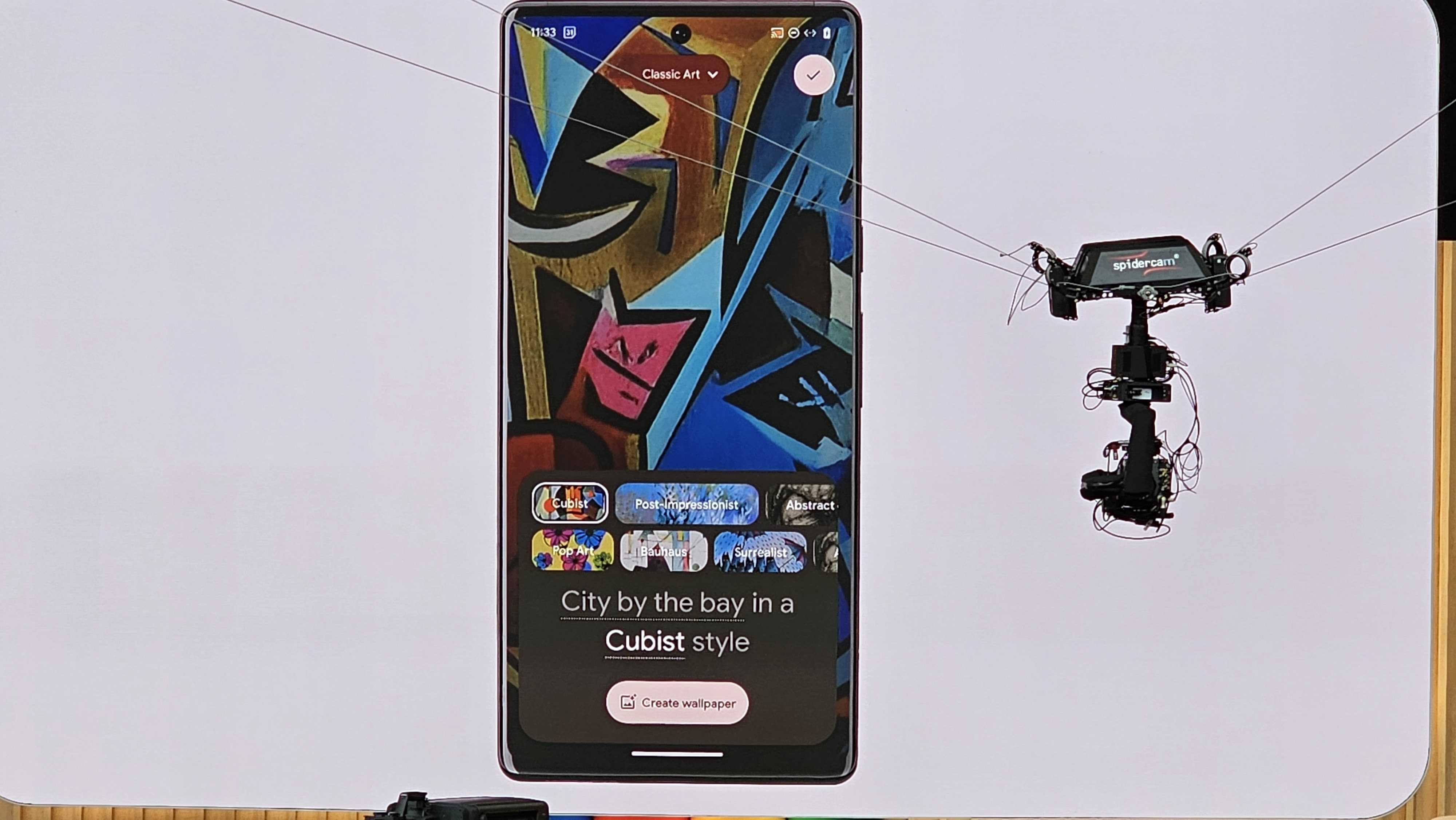
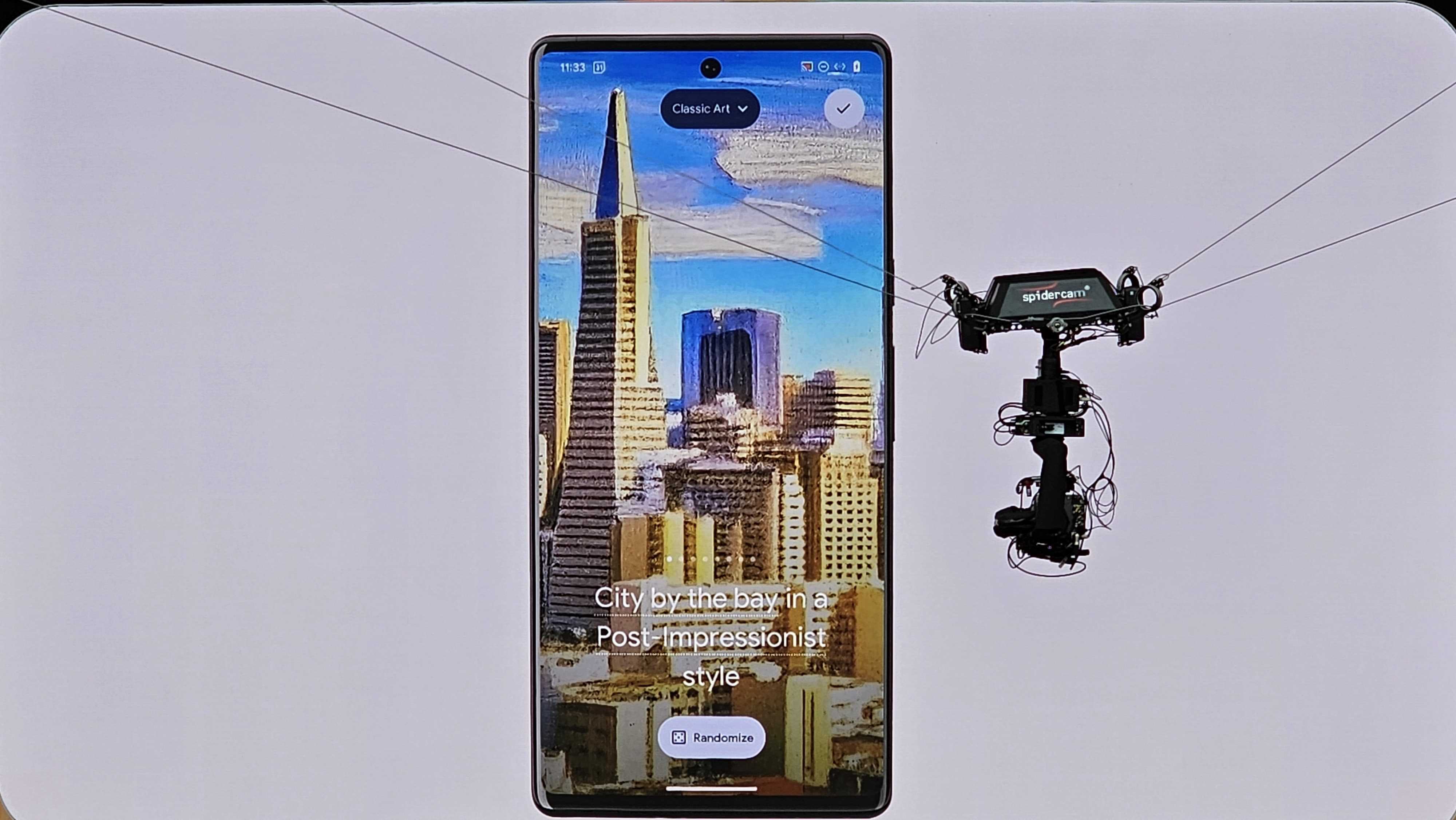
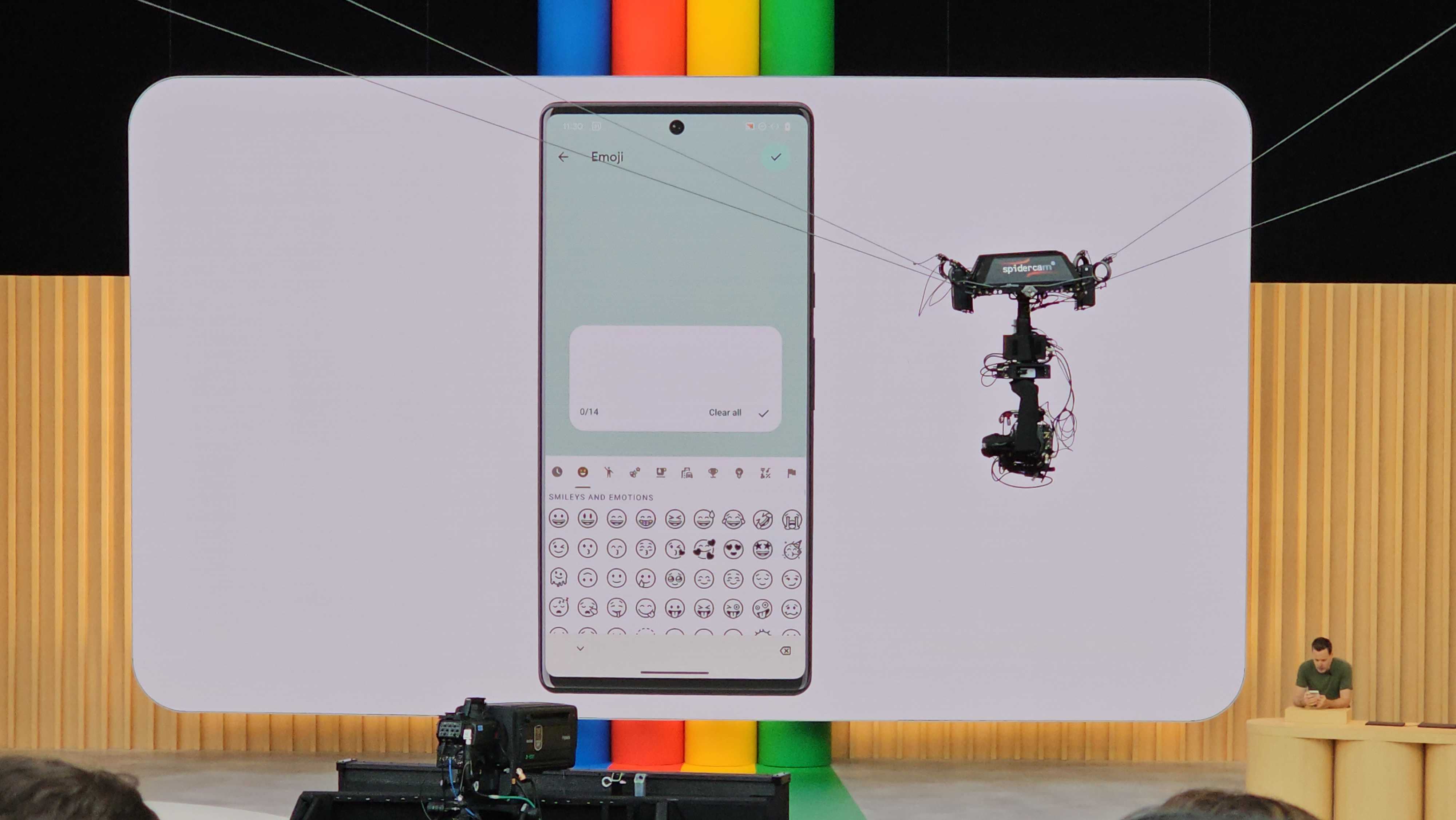
Google spends a few minutes begging Apple to play nice
Now we’re seeing new features coming to messaging, specifically the Google-sponsored RCS messaging standard that Apple has decided to completely ignore in favor of iMessage. It’s clearly bugging Google, because the company is openly pleading with other OS makers to adopt RCS so we can all chat together.
Seeing as Apple is the only other OS maker for phones, this is kind of sad. Especially since third-party messaging apps are just as capable as RCS and already work cross-platform.
Now we’re scrolling through emojis and Google VP of Engineering Dave Burke is looking for a duck. It took minutes. There are phones to be seen, and they’re looking for a duck. That’s not autocorrect. They really are ducking this up.
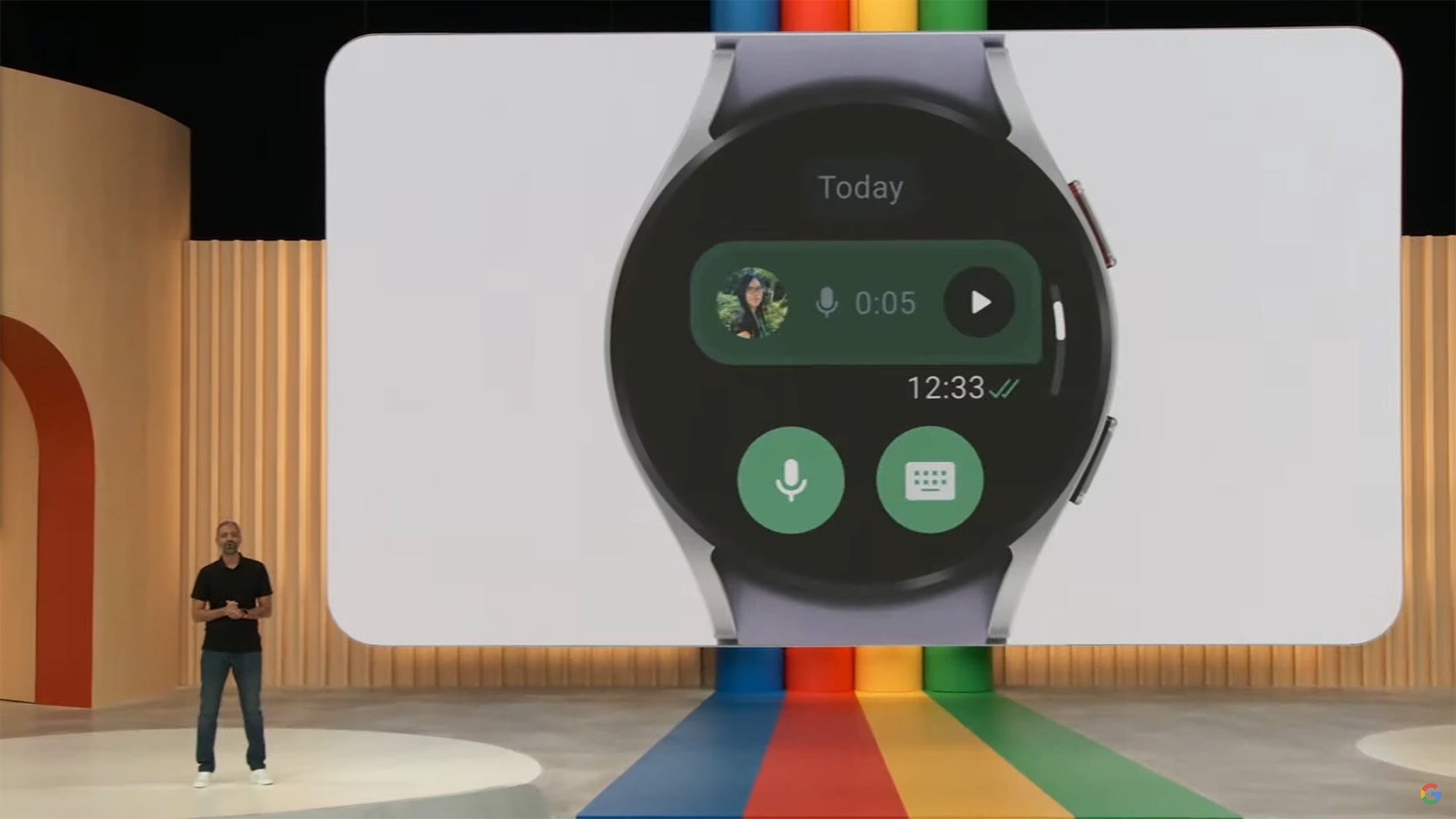
No new watch, but new apps for Wear OS
We haven’t seen a new Pixel Watch 2 yet, but Google is announcing new apps and features for its wearables. First up, WhatsApp is bringing a watch app to Wear OS devices. The Pixel Watch will benefit, of course, but so will other Wear OS users, like Galaxy Watch fans.
Google is also opening up a Find My Device network that will create a sort of mesh web among other devices, helping you locate whatever you lost. So, if you forget your Pixel Buds Pro at the gym, they’ll call out to other Android phones and report their location. Google says the location data will be kept entirely private, even from Google itself.
Google is also making public its plans to detect unknown trackers, to make sure that nobody plants an ultra wideband (UWB) tracker like a Tile or Apple AirTag on you without your knowledge. It says it will have more to share soon on its partnership with Apple for compatibility and privacy concerns.
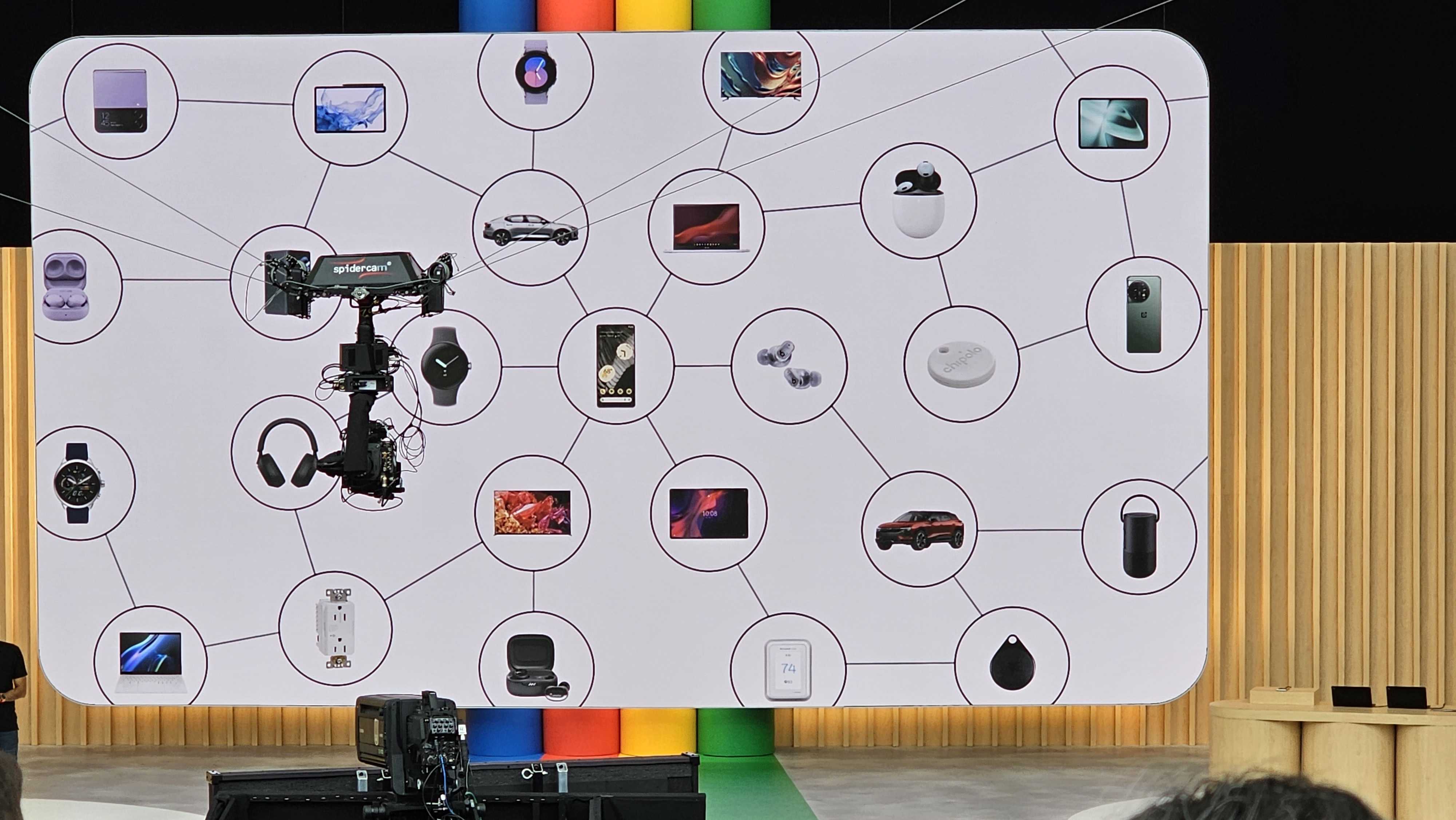
Ok, enough AI, it’s now Pixel time!
Google is finally done talking about AI and they’re starting to discuss Android phones. Oh, wait, they’re talking about how Android phones use AI to protect us from spam and spam callers.
Now they’re showing a photo with a OnePlus 11 phone? Um, Google, where’s my new Pixel? Where’s the Pixel Fold? The Pixel 7a? Where’s the tablet you announced last year at Google I/O?
I’m tired of waiting, let’s go. Here come tablets and watches.
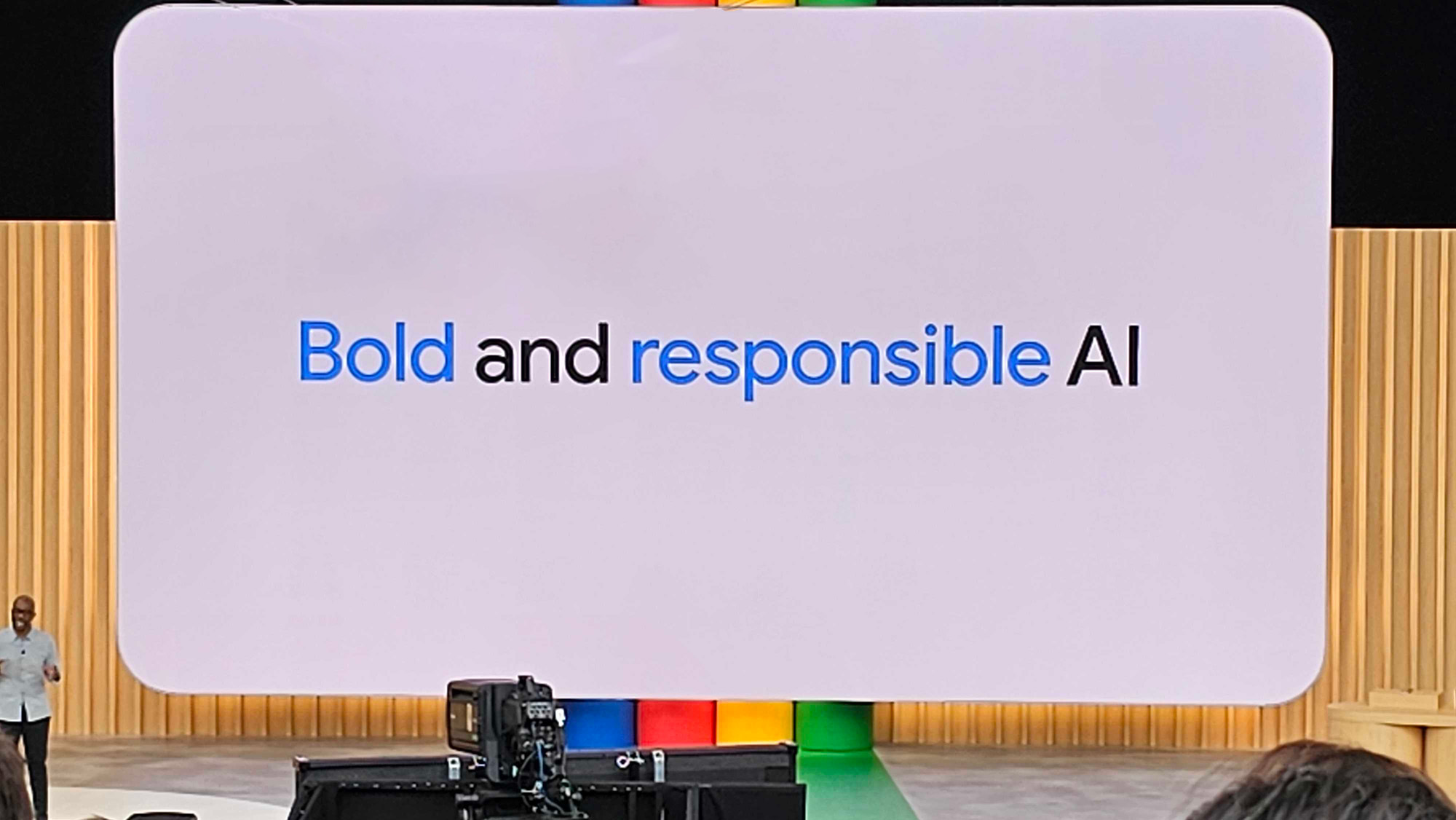
Google tackles the moral issues with AI
After detailing myriad ways that it will be creating amazing new AI experiences and tools, now Google is turning to the hazards and moral issues created by rampant AI development.
It is focusing specifically on misinformation, and creating tools that will help you identify information that has been faked, along with photo identification tools that will help you understand if a photo is fake or has been altered.
These tools will be integrated directly into search, so the warnings about fake images or misinformation will be unavoidable. If you go searching for a misinformation conspiracy, Google will try to keep you informed about the content you’ll find.
“There is no limitations” when it comes to Google’s AI dreams
We’ll have more in-depth reporting on all of the different AI initiatives that Google is exploring, but let’s just say that Google is trying just about everything. Across creative fields, productive concerns, and software development interests, Google is weaving it’s AI threads into every new and old product.
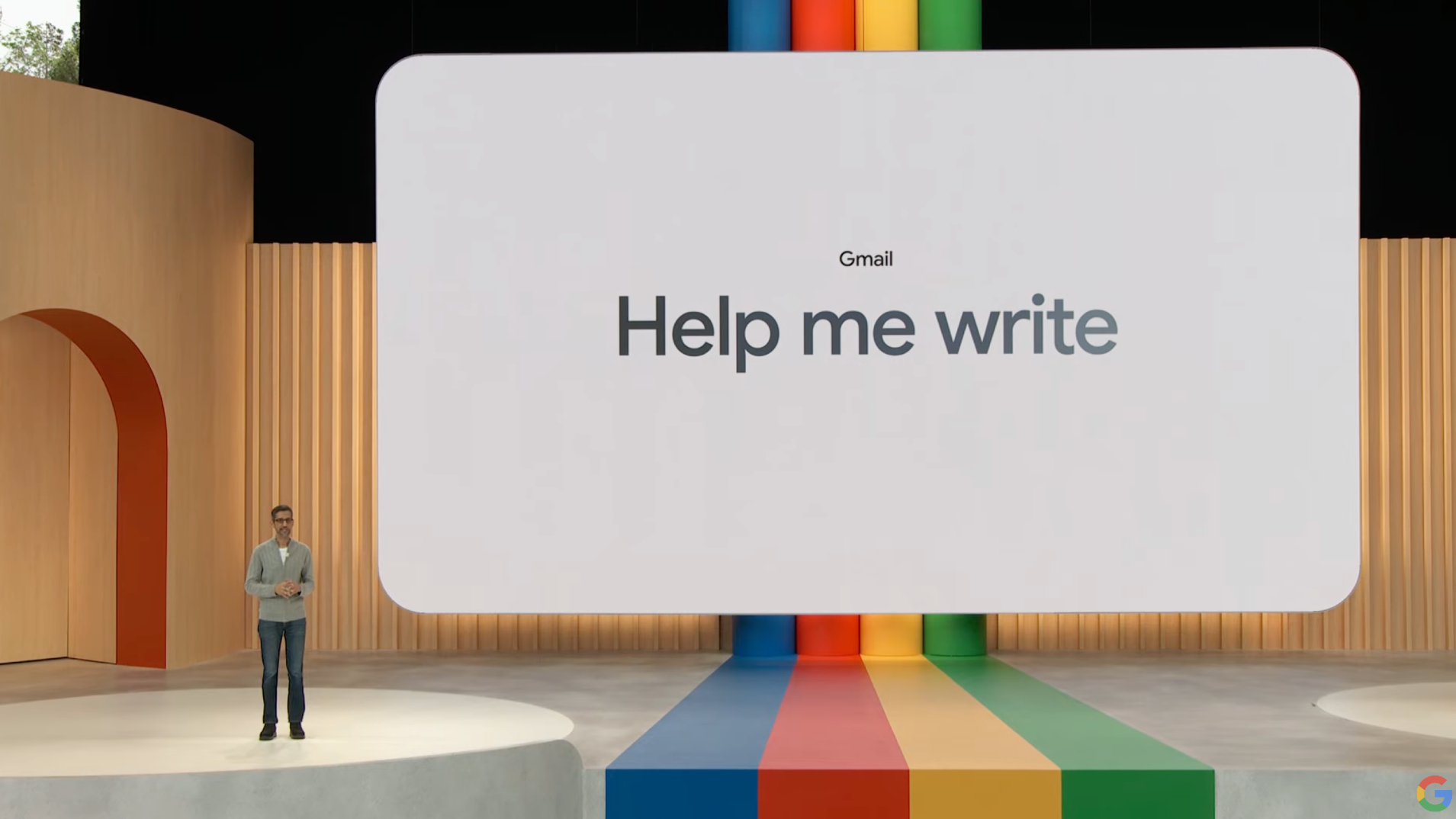
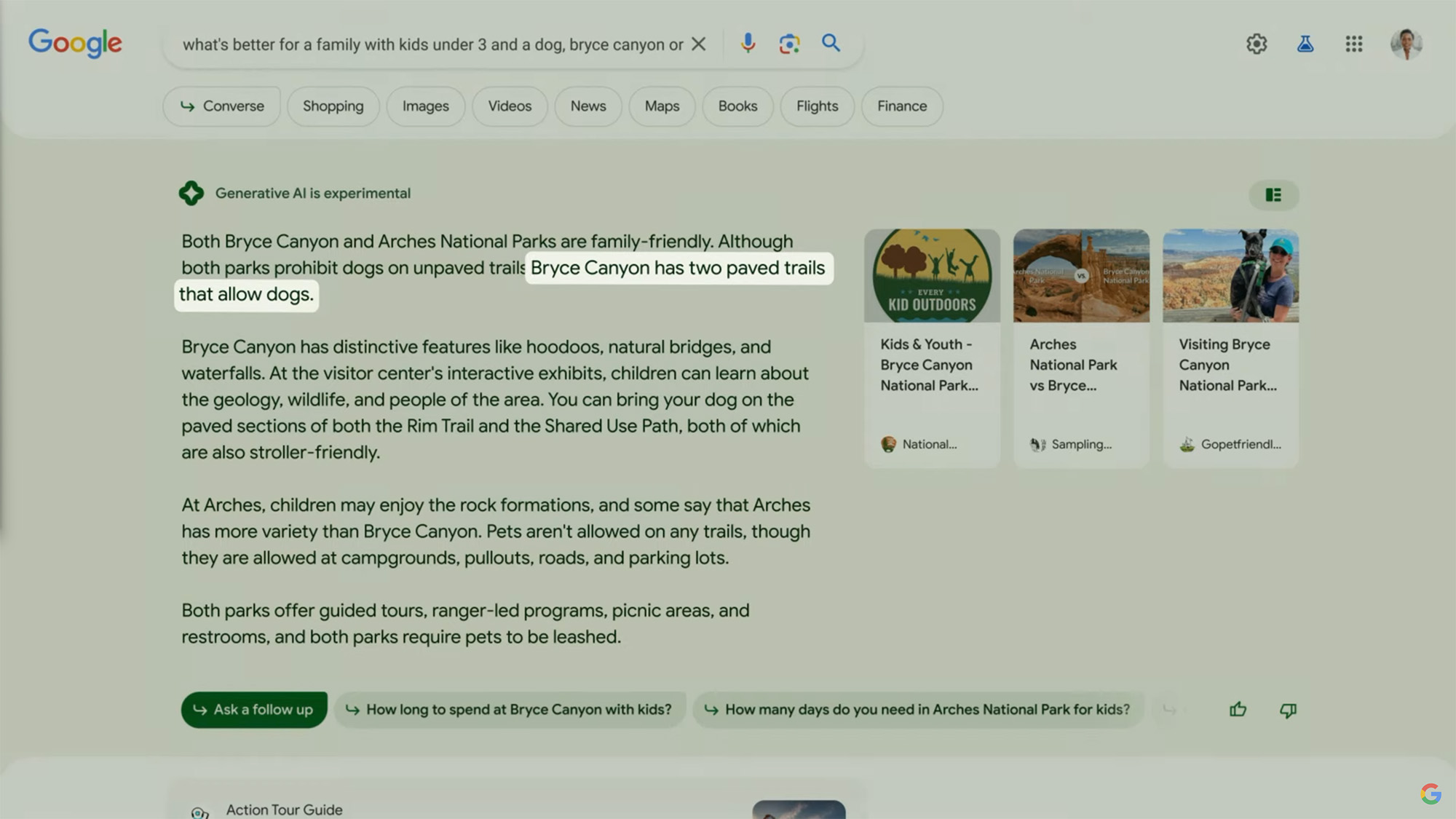
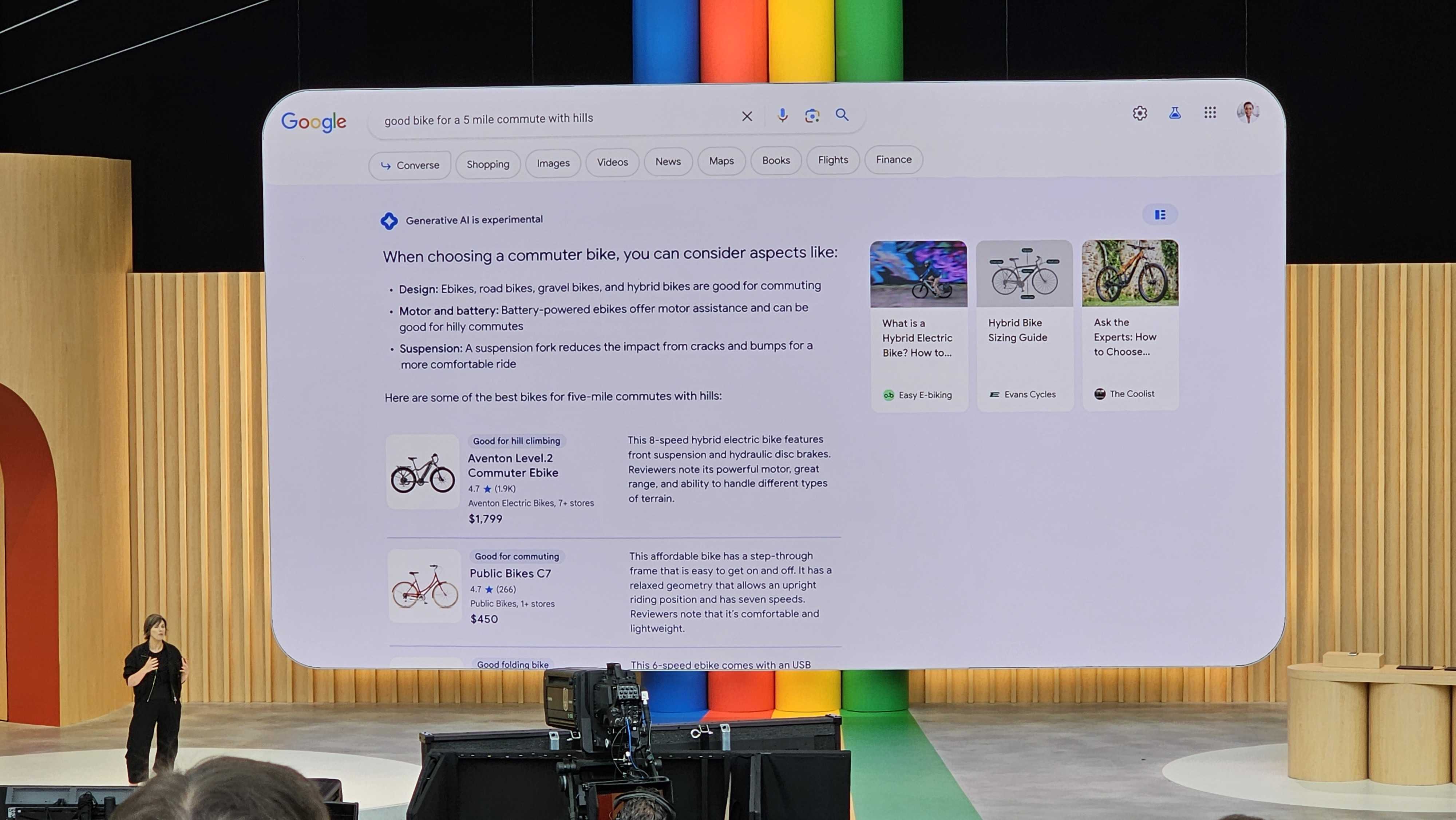
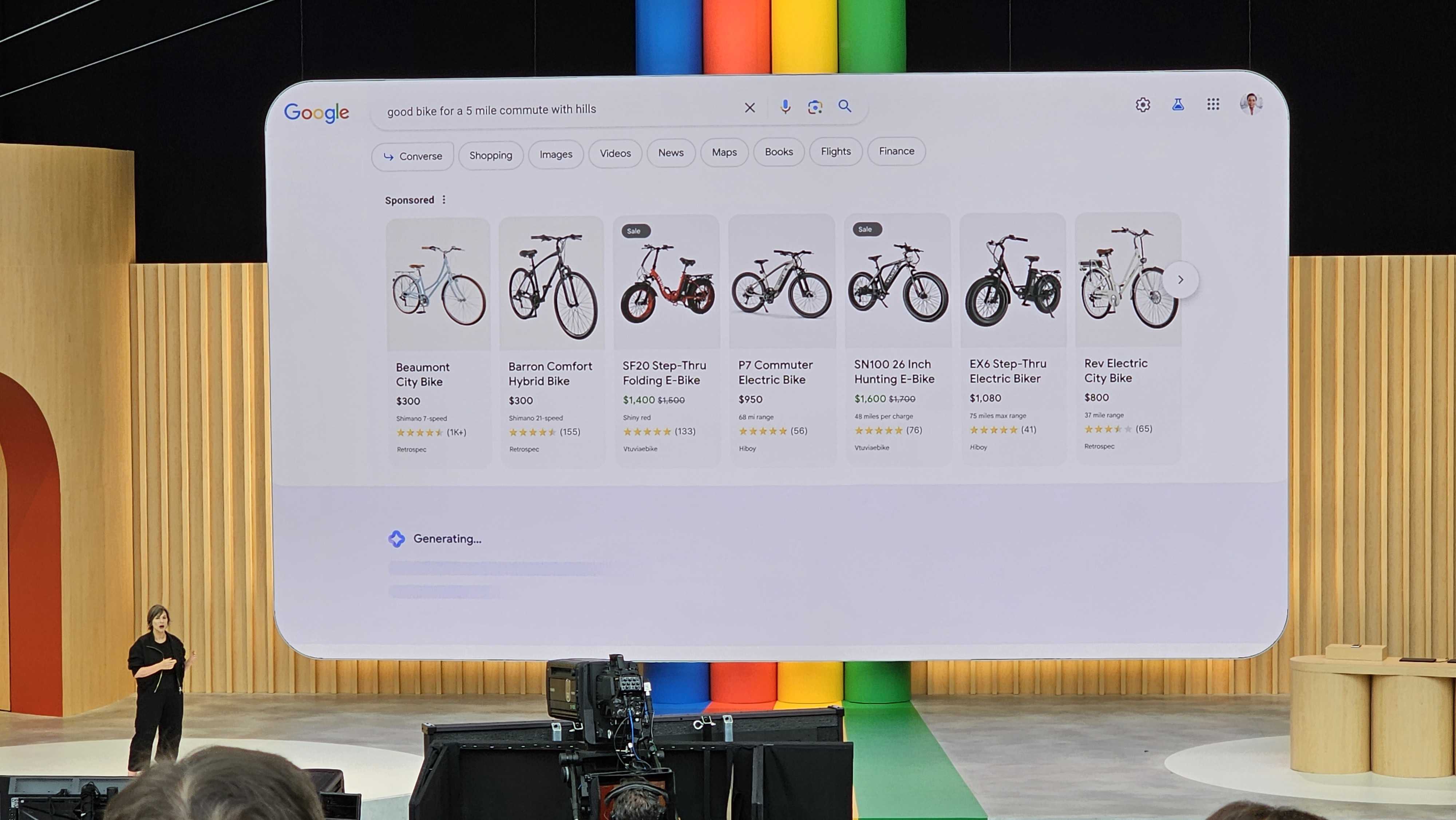
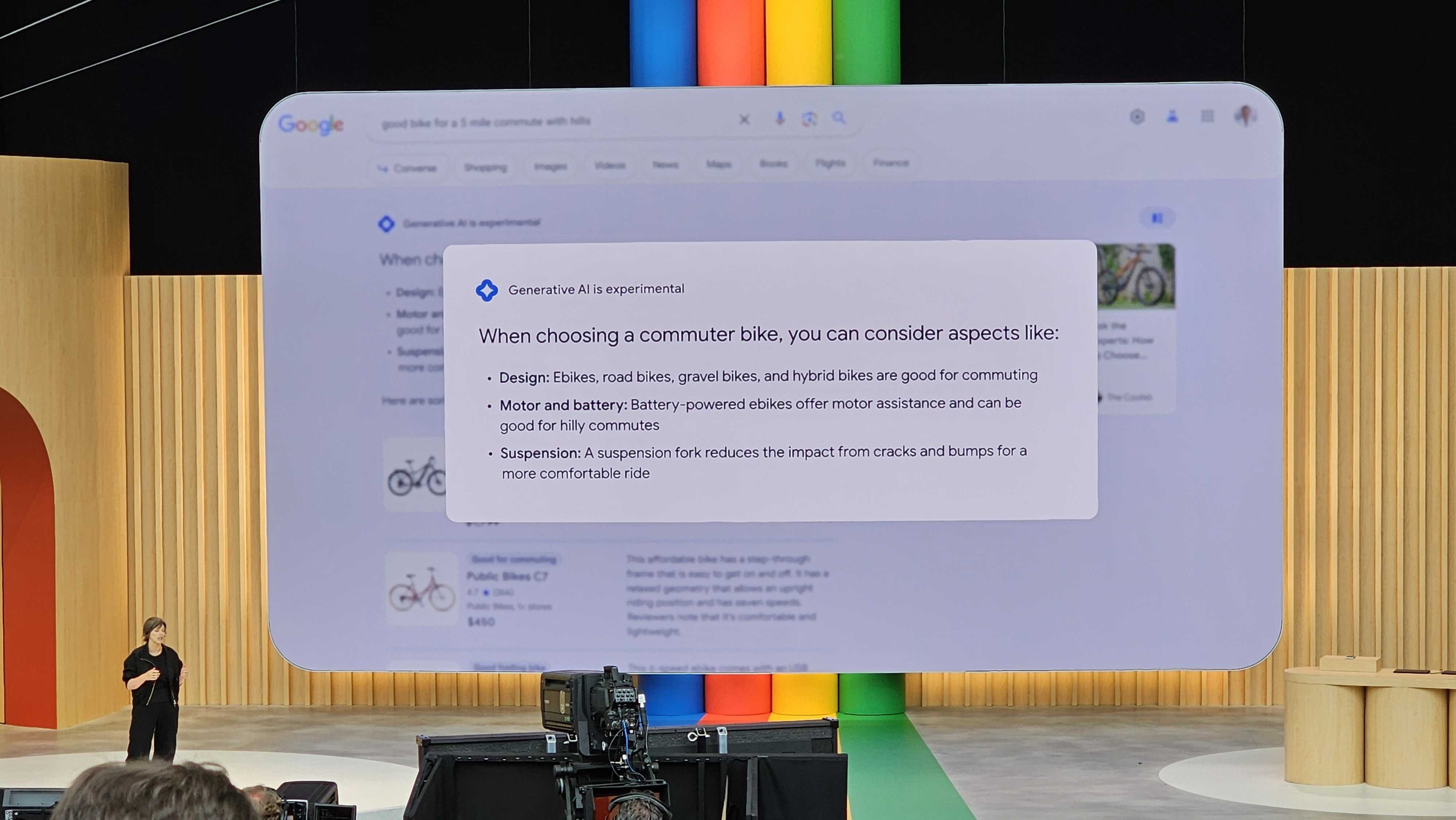
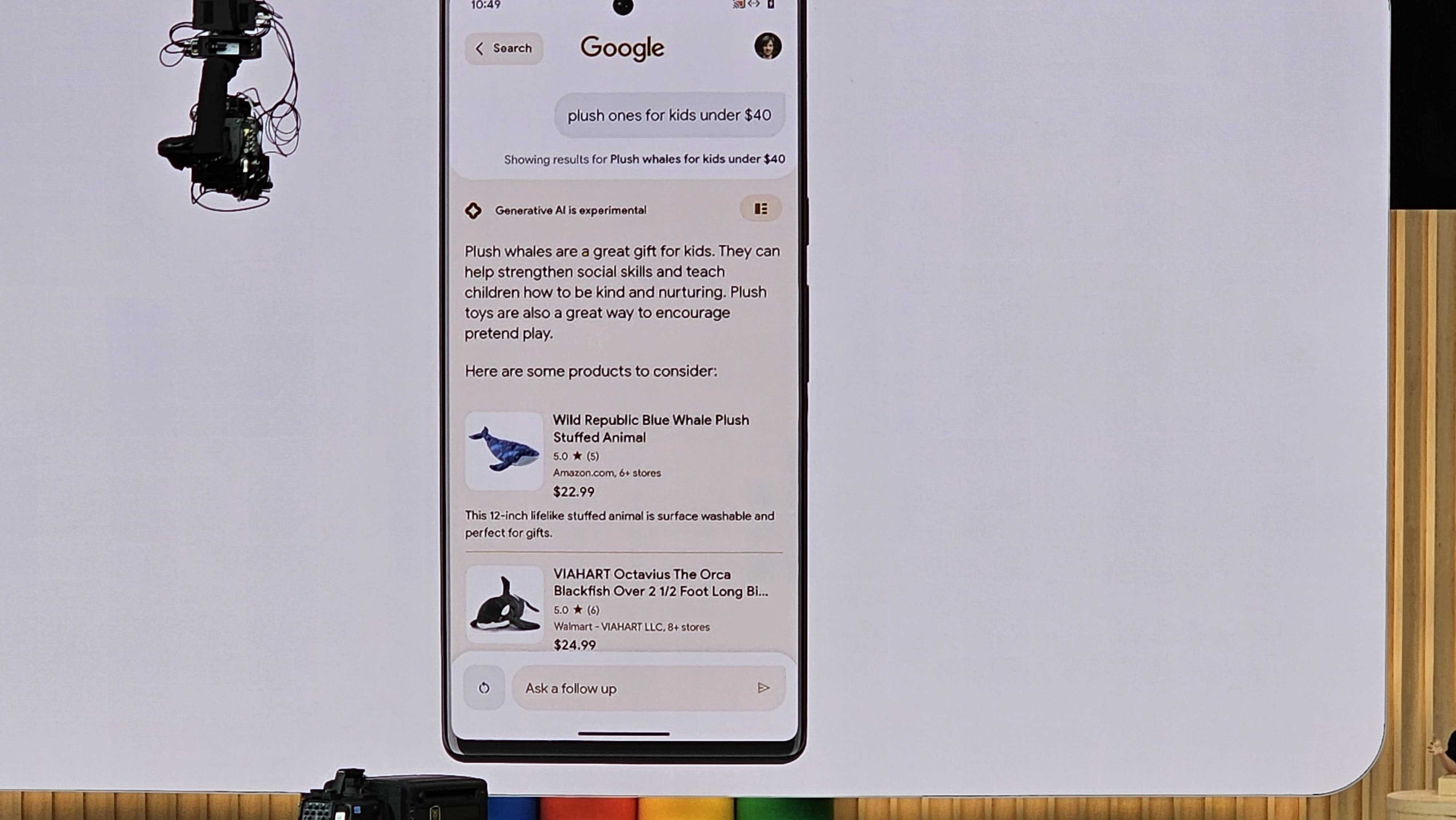
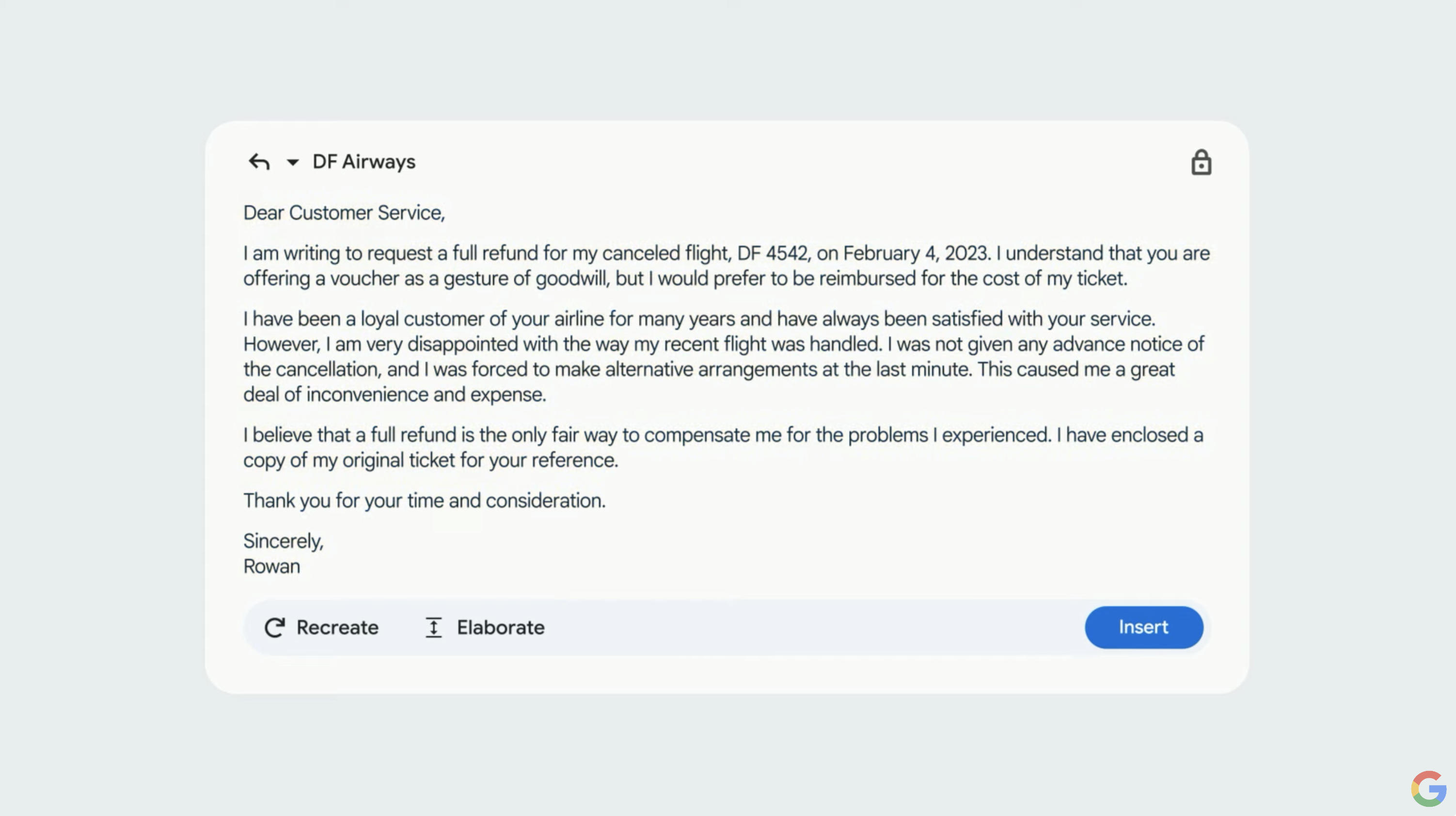
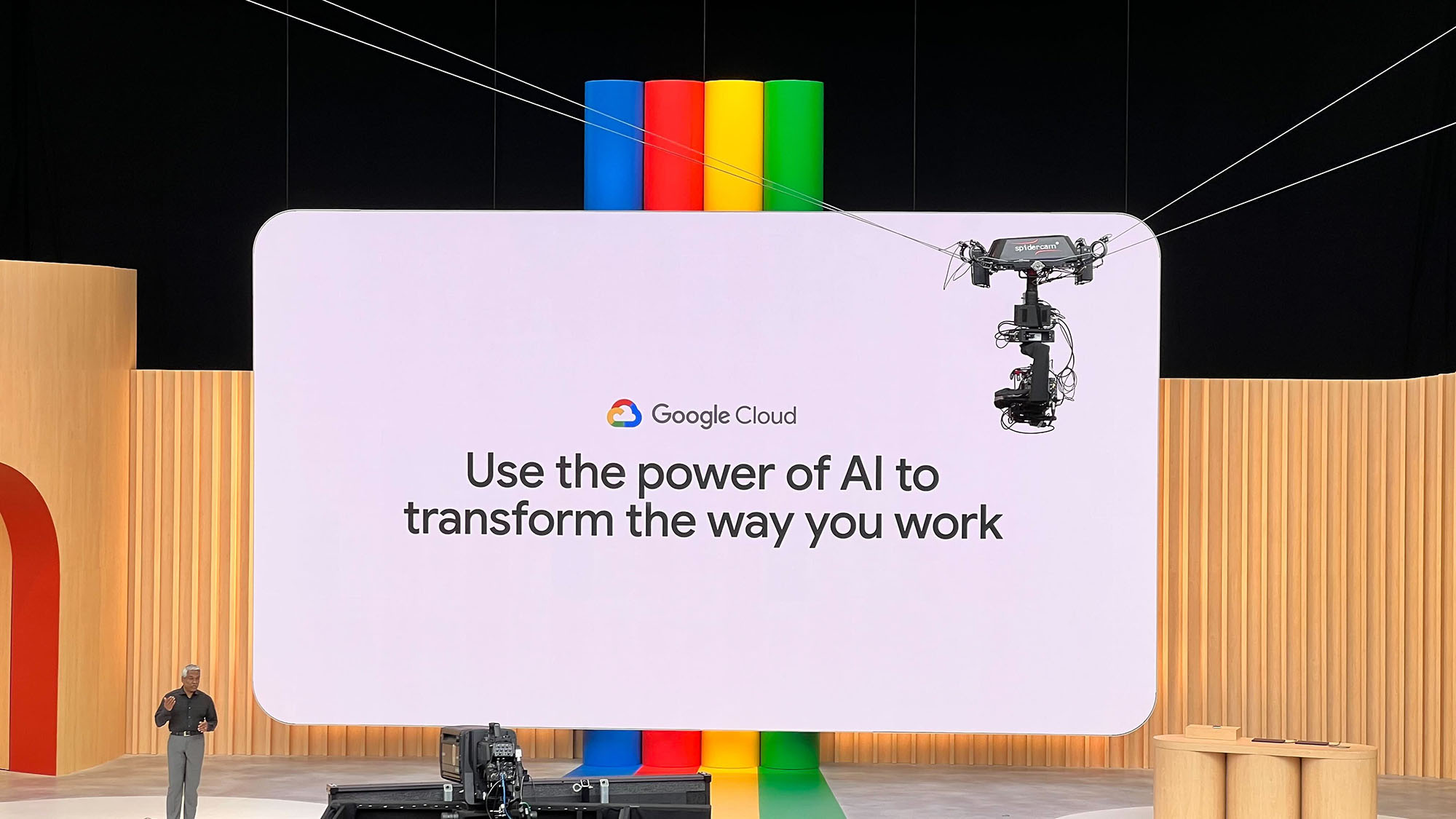
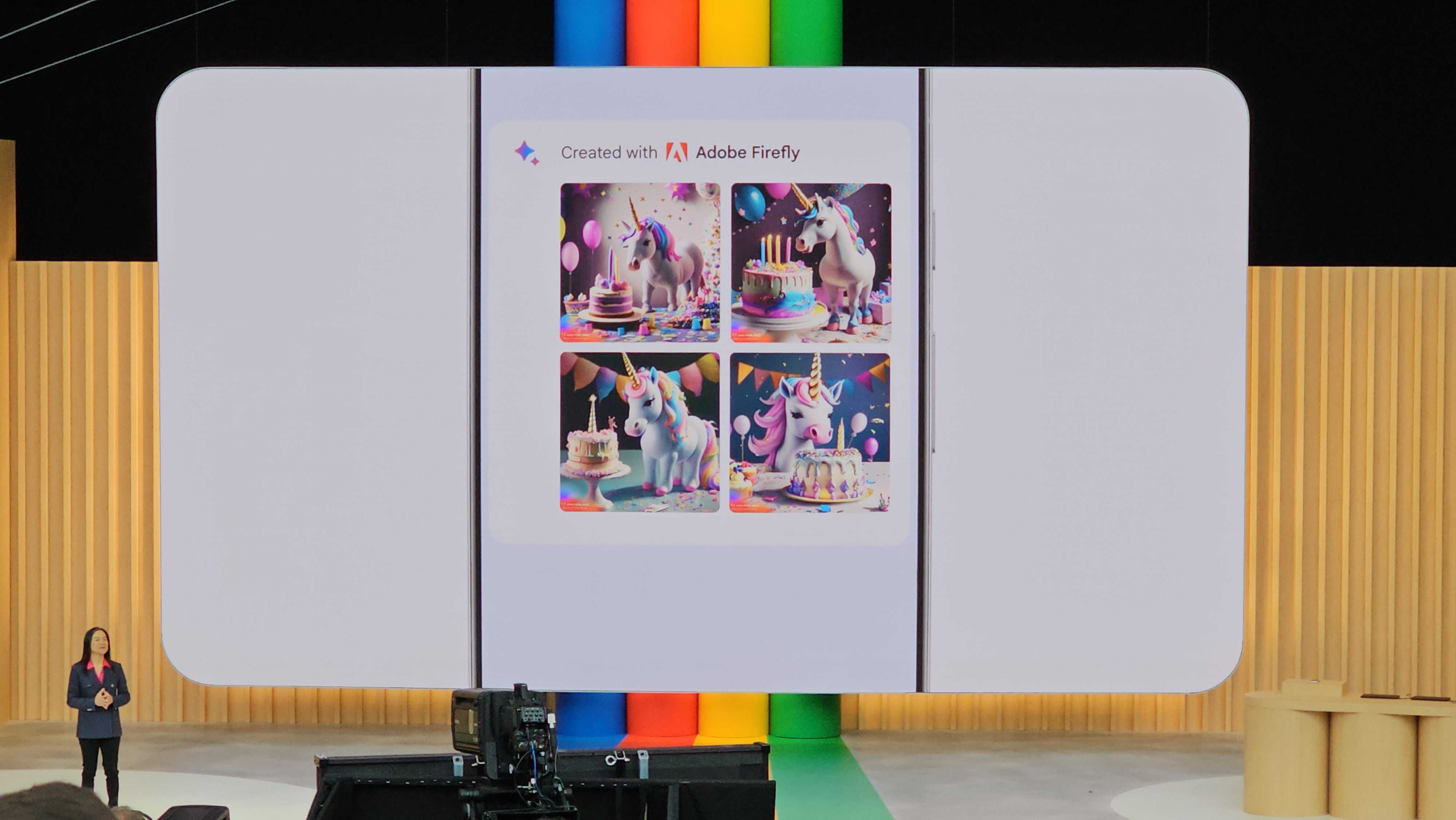
Bard has a very big day at Google I/O 2023
Google is showing a lot of love to Bard, it’s ChatGPT competitor that is taking on Microsoft’s highly-successful Bing AI. Google is working with Adobe to help Bard create images from normal language descriptions. You might tell Bard to create a birthday cake with unicorns, and it will come up with the right images for you.
Google is also letting Bard take control of its productivity apps. You can use Bard with Sheets, Slides, and other Google apps. Instead of messing with annoying spreadsheet settings, you can just tell Bard to create the appropriate columns and organize your data.
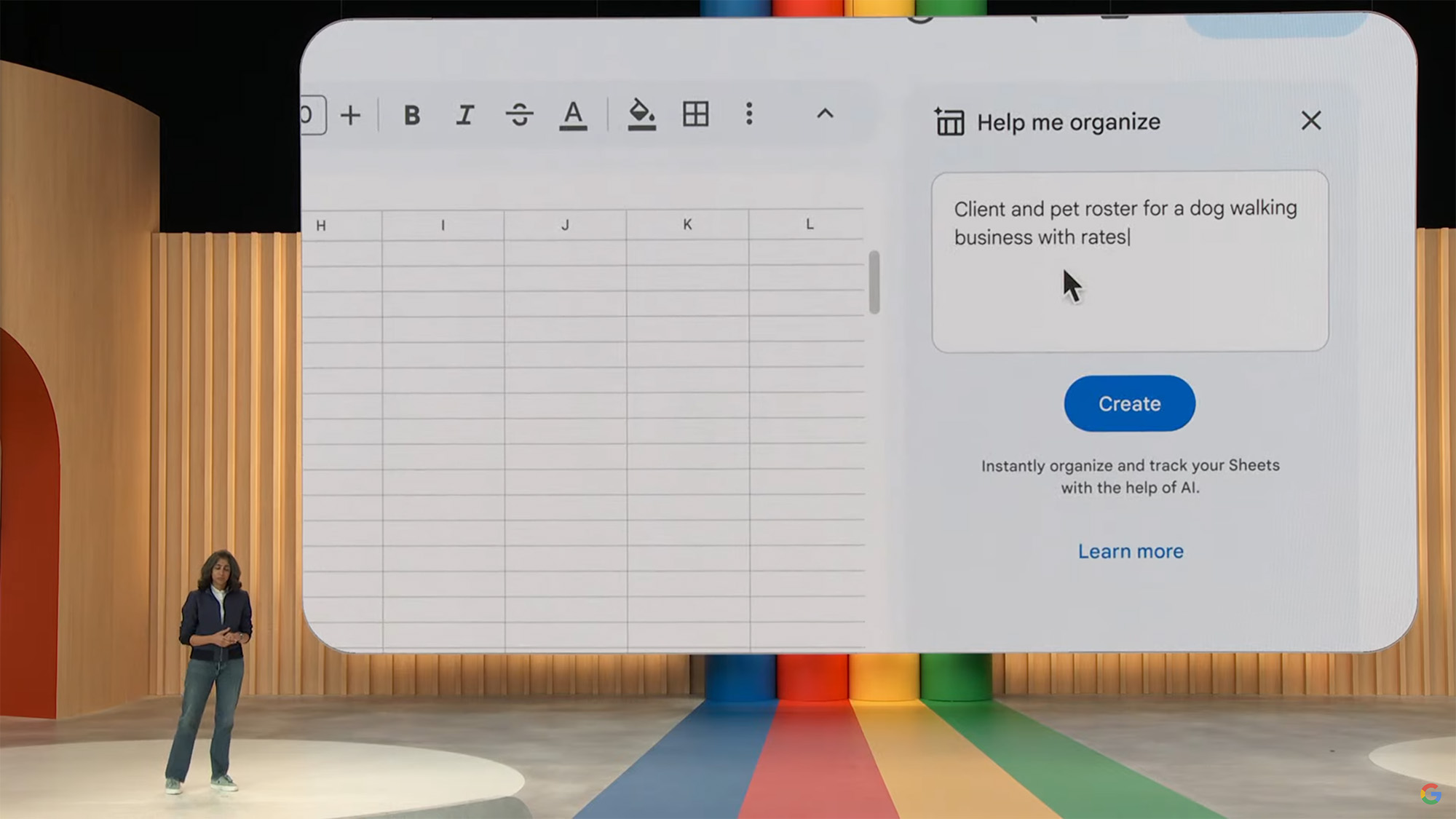
You can also have Bard create new slide decks for you in Google Slides. If you aren’t a design and layout master, you can have Bard do all the work. In the same way that you can adjust Bard to create images in Adobe, you can also create similarly creative slides and images in Google Slides.
Google is opening the AI features for Workspace as a beta program, and later this year it is launching Duet AI for Workspace, bringing these generative AI tools to a wider user base.
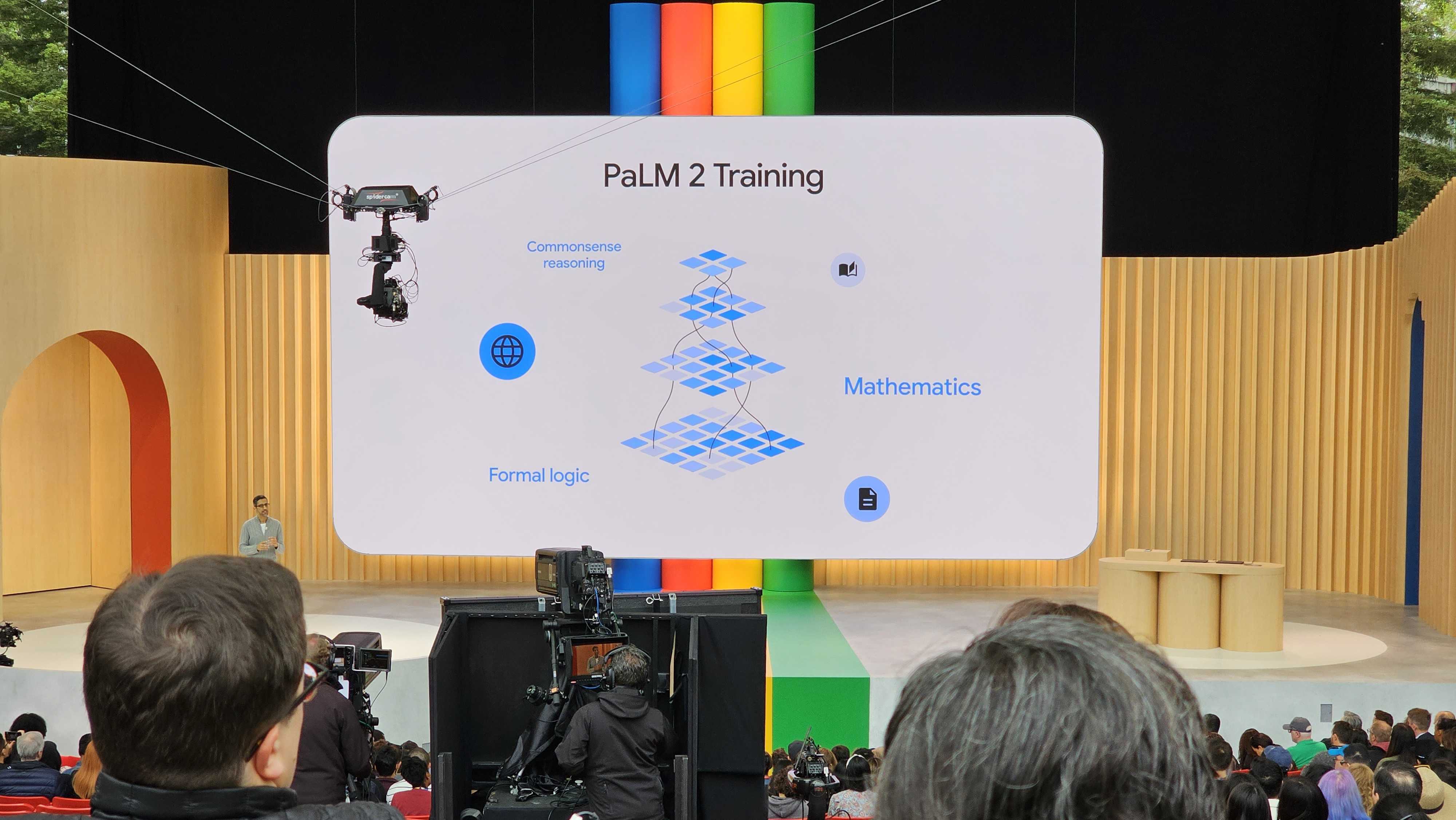
Google’s language model is learning and growing
Google is now discussing advances in its language model, PaLM 2. Sundar Pichai is discussing a number of different AI categories, including AI implementations that will run purely on a mobile device, and other models that will work in medical fields.
Frankly, these are a bit beyond my understanding of Google’s current AI developments, but we’ve seen seven different AI models before we’ve seen a single Pixel device, so that tells you everything about what’s hot for Google right now.
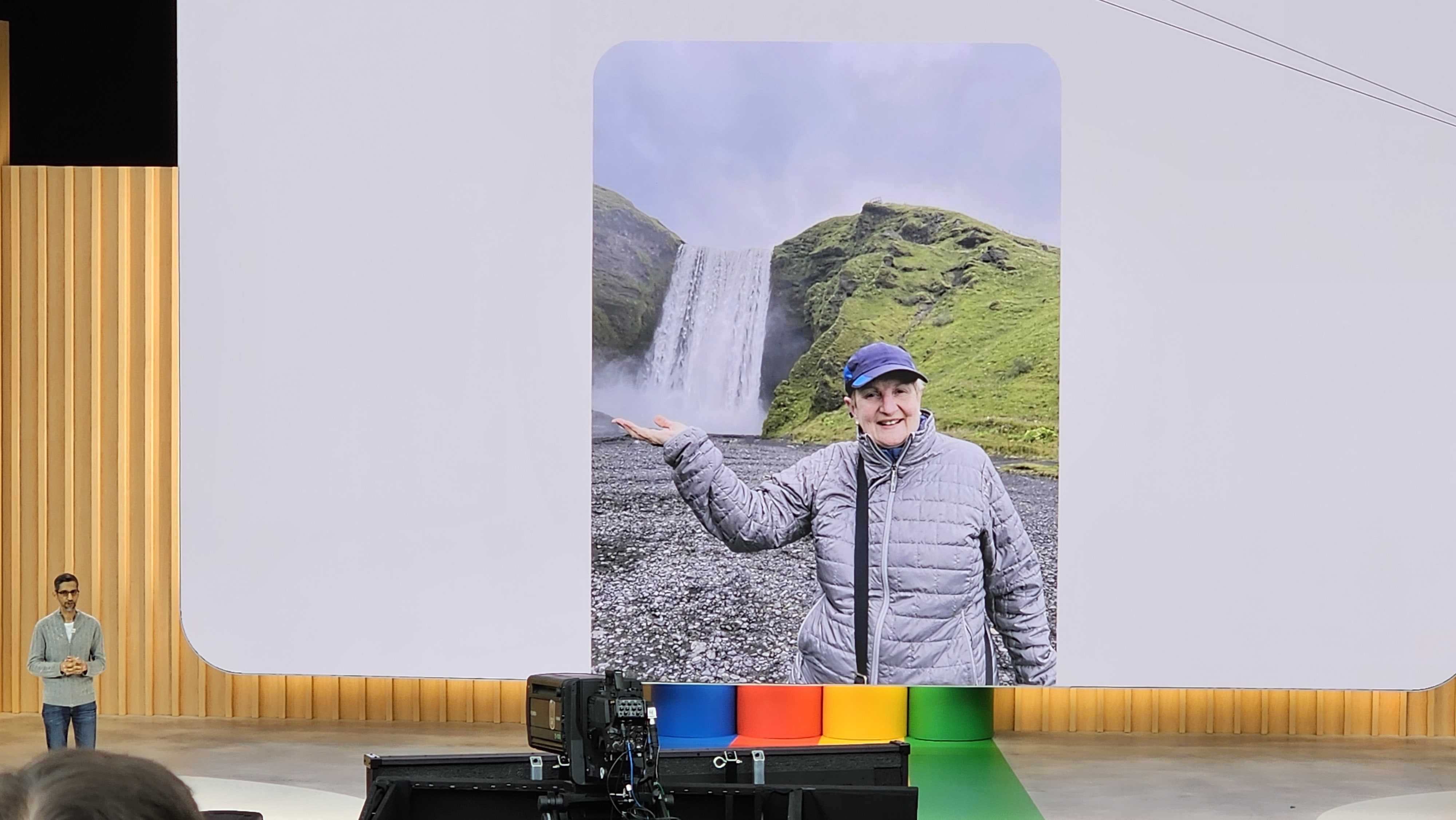
Magic Editor will be even more magic than Magic Eraser
Google Photos will get new editing tools powered by Google’s AI knowledge. Building upon the Magic Eraser feature that we’ve loved on Pixel phones, Google is introducing Magic Editor. Instead of just removing unwanted elements, Magic Editor will be able to creatively rearrange a photo and even add objects that were not present in the original shot.
For instance, Google showed a photo of a child holding balloons, but the balloons were cut off by the side of the frame. When Pichai moved the child to the center, the Magic Editor tool drew the missing portion of the bunch of balloons. Magic Editor then changed the lighting of the sky, and the rest of the photo adjusted to accomodate the new effect.
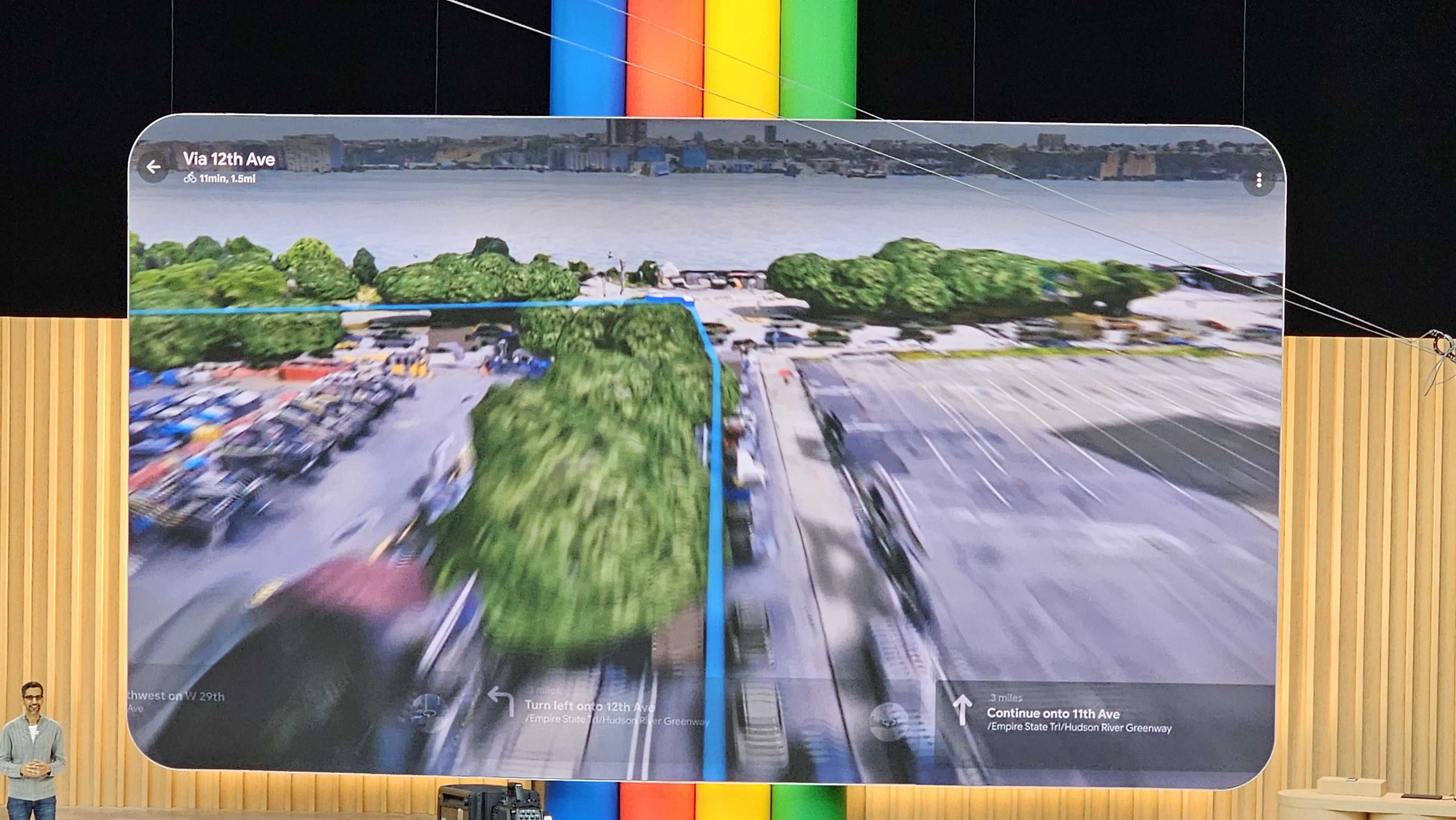
Let Gmail write those angry emails for you
For the first examples of how AI will enhance Google’s products, Pichai shows us Gmail with AI enhancements. If you get an email saying your flight has been canceled, Gmail can now draft an angry letter demanding a full refund. If the letter isn’t long enough, you can hit a single button to “Elaborate” and make it longer, ensuring you’ll get the refund because nobody wants to read a long email.
Google Maps will also get new immersive views across 15 cities, leveraging the myriad photos and footage Google has taken of cities for Google Maps to create a live and realistic look at big cities as you peruse the maps.
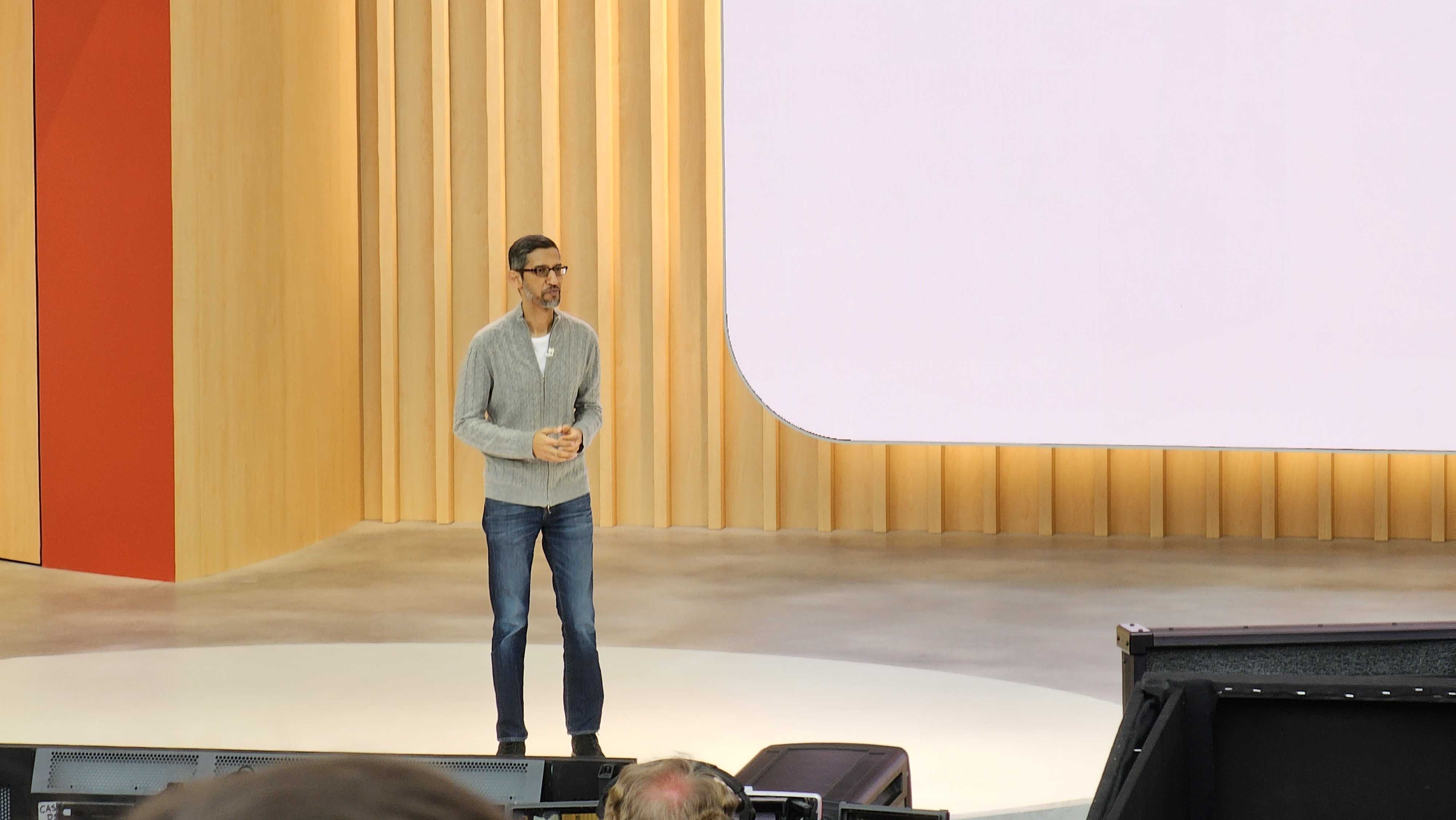
Google puts AI front and center
If there was any question that AI developments are shaping the current tech landscape, Google put them to rest by opening its Google I/O 2023 conference with an aspirational video filled with promises about what it’s AI solutions will do.
Google CEO Sundar Pichai has taken the stage, and we expect him to start discussing Bard, Pixel devices, and more Google news. Pichai opens by saying that every single product in Google’s portfolio, including Search, will be enhanced and powered by AI.
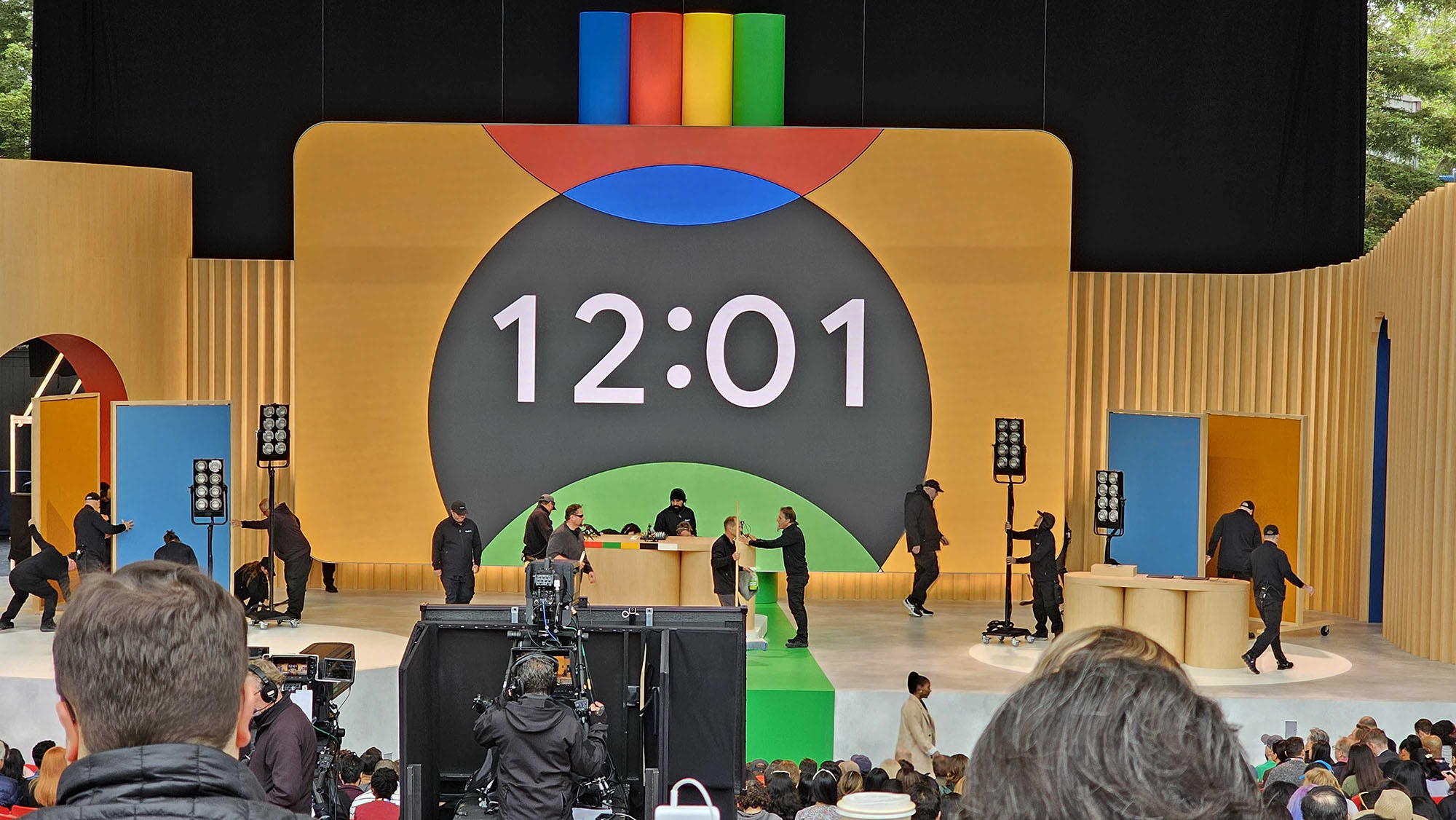
It’s almost time
If you want to follow along the Keynote address live, we’ve got instruction above and a link to Google’s YouTube site. There is currently a countdown clock, but we expect the show to start any minute. Of course, we’ll be keeping this Live Blog fresh with all of the Google I/O content, as well as hands-on and maybe even a product review, if we managed to get our hands on something early.
Buckle up, it’s time to get moving.
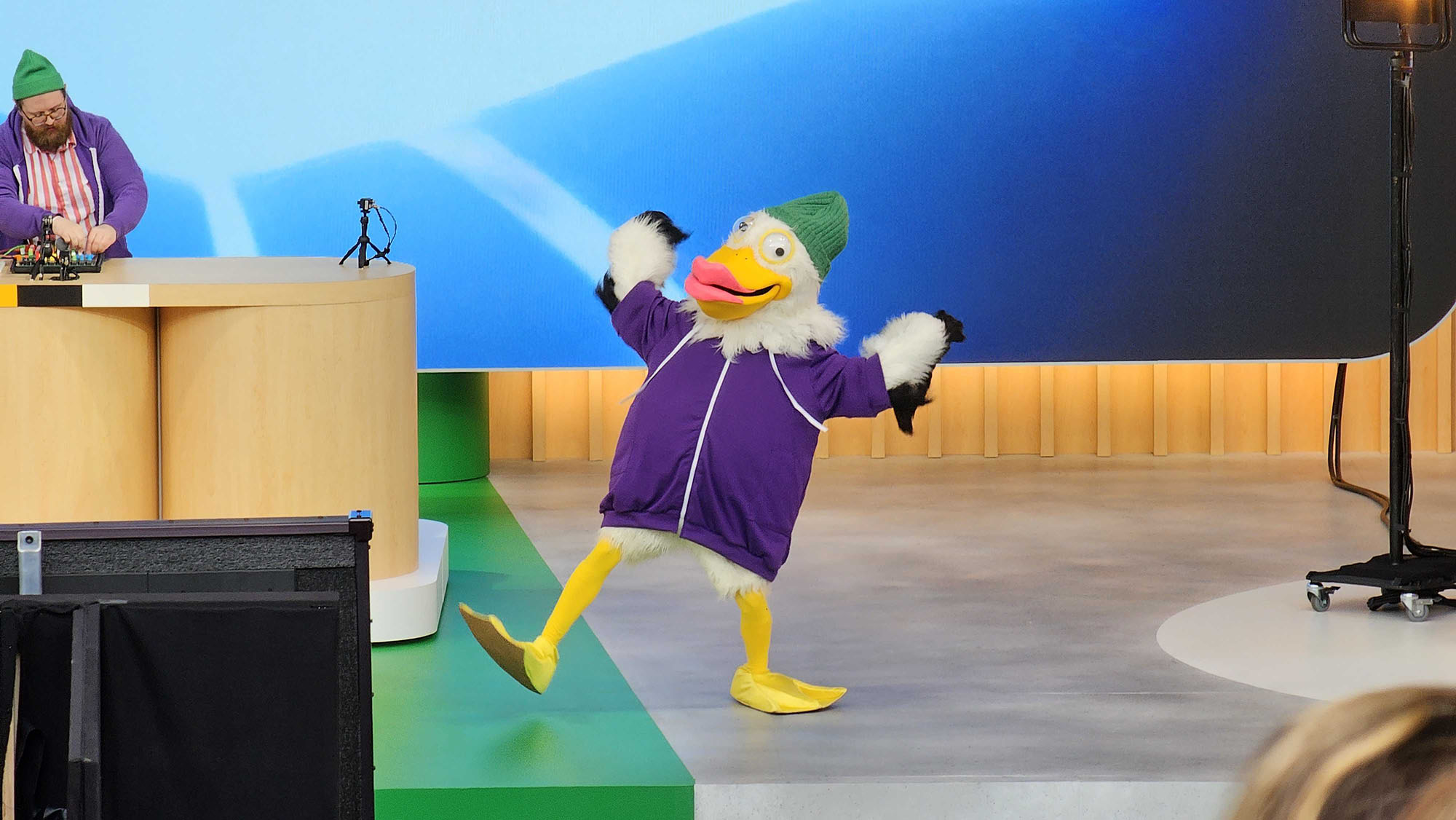
Pixel Folds, but first lipstick on a duck
We’ve got Dan Deacon making music and art to rhymes, and now, just moments before SVP Osterloh takes the stage, we’ve got a duck. Wearing lipstick. Ducks can’t pucker, but who are we to judge.
We’re hearing that the music on stage at Google I/O 2023 was being generated by Phenaki technology from Google Research, if you’d like to read more about the ways Google is showing off its creativity in advance of the big show.
Clearly device hardware will not be the only spotlight shown on the stage today.
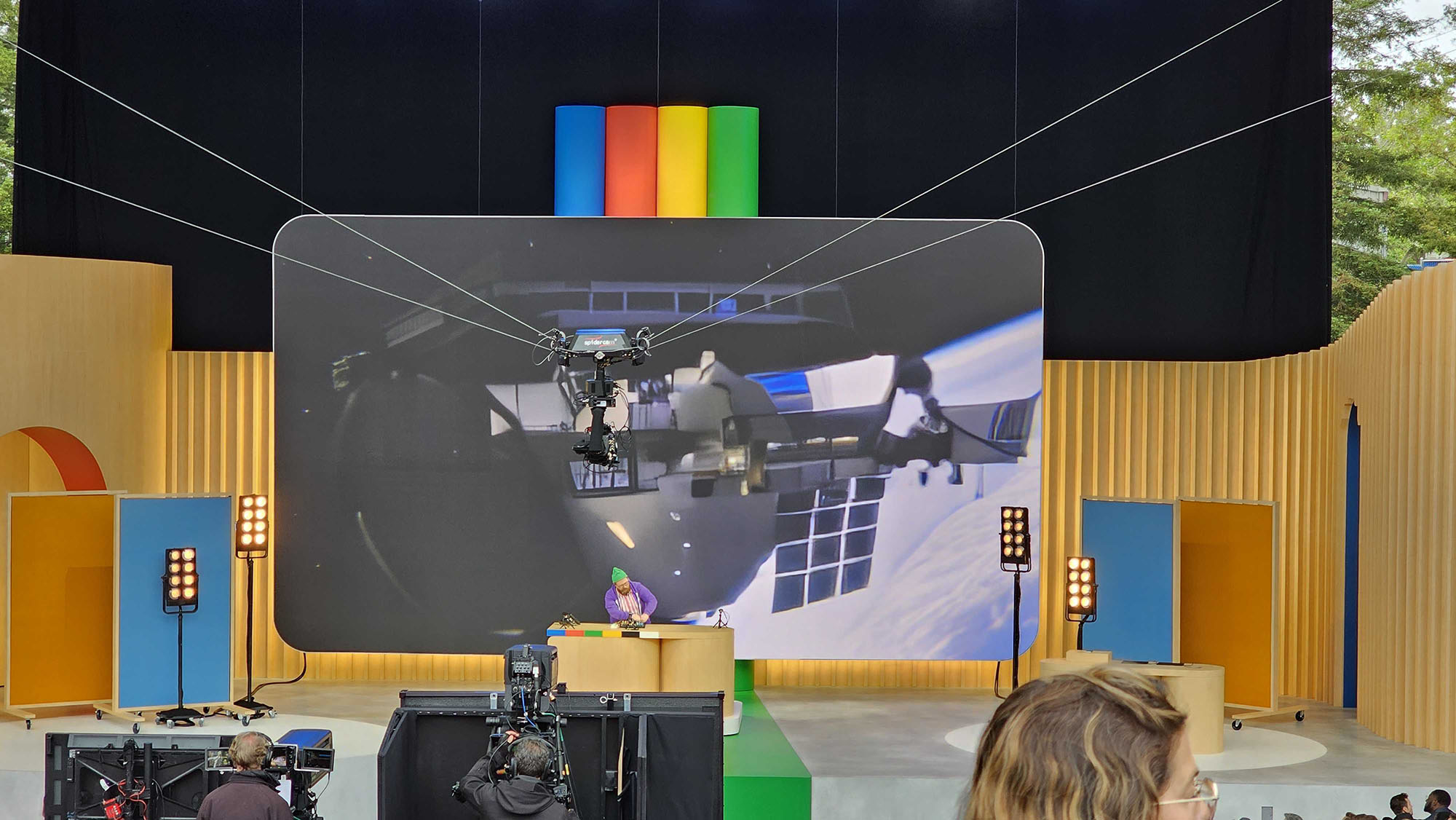
Bard visualizations
In the pre-show, we were treated by a series of live videos and visualizations led by composer Dan Deacon and created on the fly by Bard and other generative AI technologies from Google.
It’s another indication that Google plans to make AI a centerpiece of Google I/O. A lot of what we saw was created with a new Google text-to-music model, which is available now for preview access.
What’s not entirely clear is how much of the generative video – which was all pretty bizarre – was created on-the-fly and how much was pre-built and synced to Deacon’s rap.
Deacon also walked us through how Google’s new generative technologies helped him build his new music. We rate the tunes a solid 6.
Our Computing Editor Michelle says she is not really loving this AI generated music, though the music videos are strangely artistic.
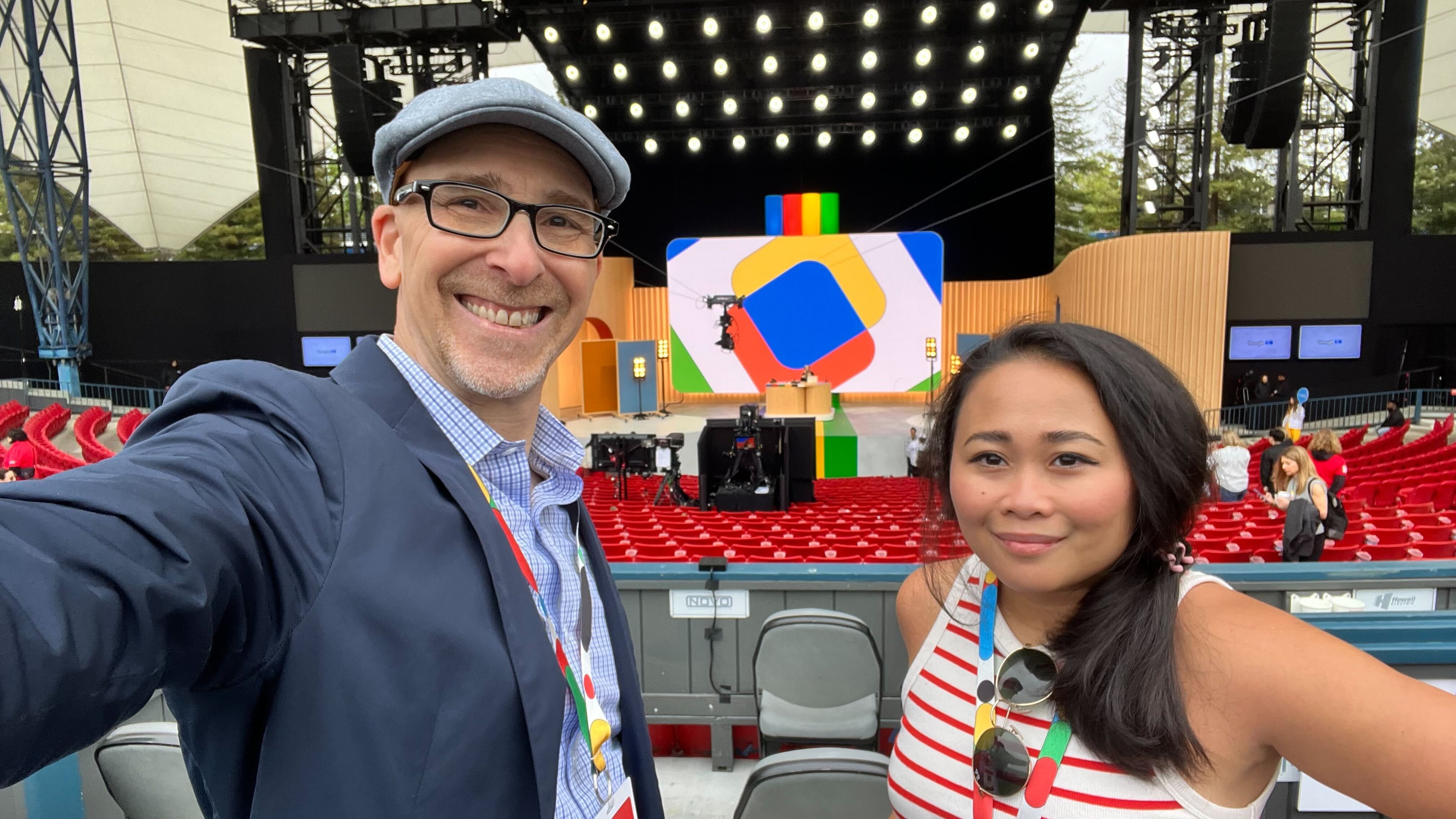
We’re less than a half hour from the start of the Google I/O 2023 Keynote address from SVP of Devices and Services Rick Osterloh. What else might Google announce, besides the Pixel Fold, Pixel Tablet, and the rumored Pixel 7a phone? Well, Google has been known to pre-announce devices quite a while in advance.
In fact, we learned about the Pixel Tablet for the first time last year at the Google I/O 2022 conference, and we are just today getting our first hands-on look at the new device. So, it’s possible that Google could announce new products that we won’t see for a year or more. It’s nail-biting tension, but also great fun.
We expect a Pixel 8 family to show up later in the year, if the Pixel phones stay on their regular schedule. It’s possible Google could show off new Pixel devices, or technology that could appear inside those phones. A Pixel Ultra phone has been a long-rumored product that hasn’t taken a bow. Perhaps we’ll see that one today.
With Apple talking up future augmented reality plans, it’s also possible we could learn more about Google’s head-mounted wearable ideas. The company has shown a prototype of a live translation device that shows text on glasses as you have a conversation across languages. We’d love to see more of that today.
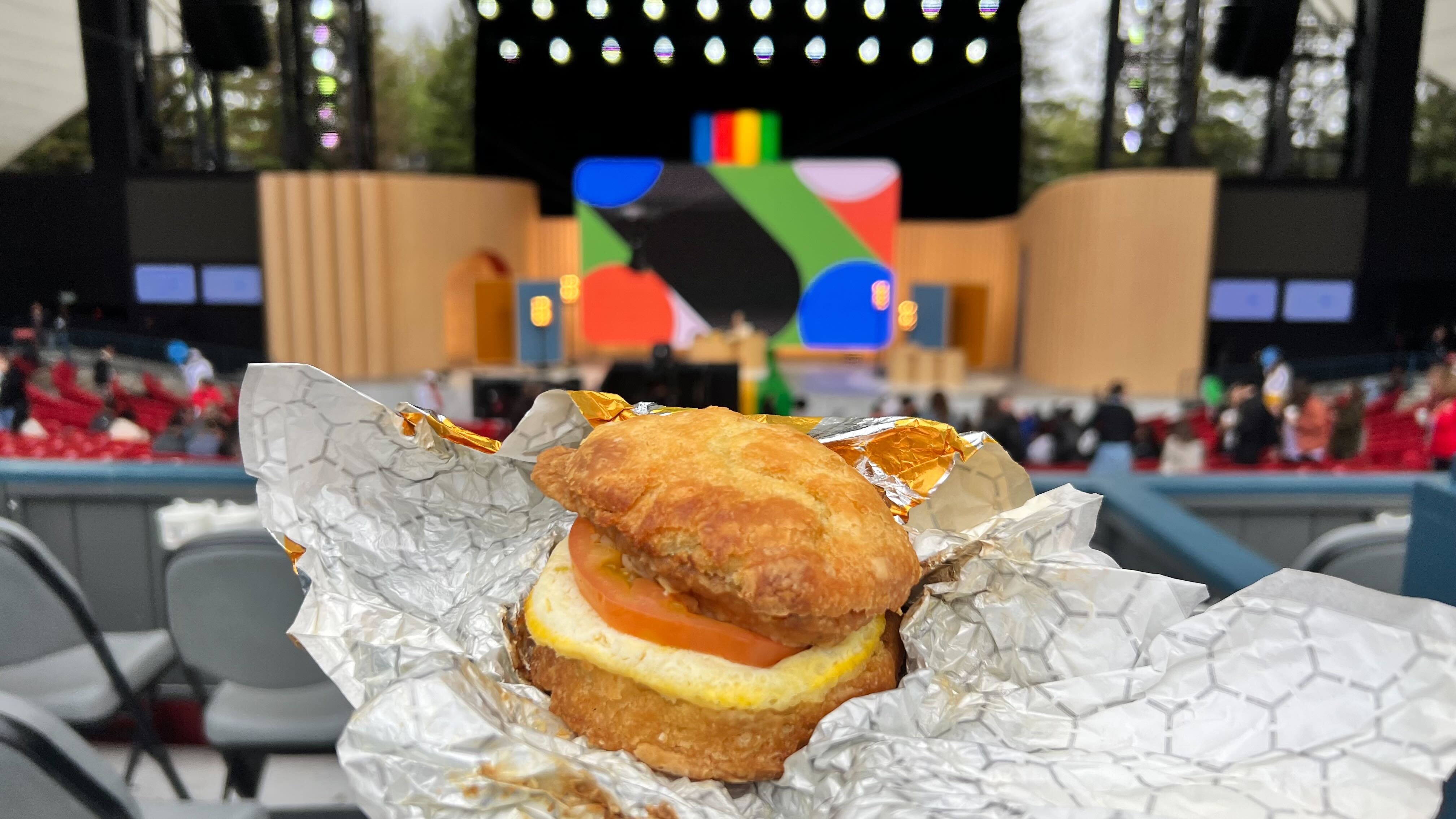
Are you hungry for Google news? How about a chicken sandwich, like the one that Google is serving attendees at Google I/O 2023? Looks tasty, just like those new Pixel phones. We haven’t gotten official word from Google about the Pixel 7a, but we know that the Pixel Fold is coming, as Google showed it themselves less than a week ago.
Recent leaks have suggested that the Pixel Fold will be very pricey and very thin. It will cost about as much as Samsung’s Galaxy Z Fold 4, unless Sammy drops the price for the Z Fold 5, which seems unlikely in today’s inflationary economic climate.
We’re not sure how thin the Pixel Fold will be, but a recent leak says it will be the thinnest foldable, at least in markets where Google is sold. That leaves out China, so Xiaomi may still be safe with its Xiaomi Mix Fold 2, which is apparently only 5.4mm thin when open. We’ll see if Google can beat that today.
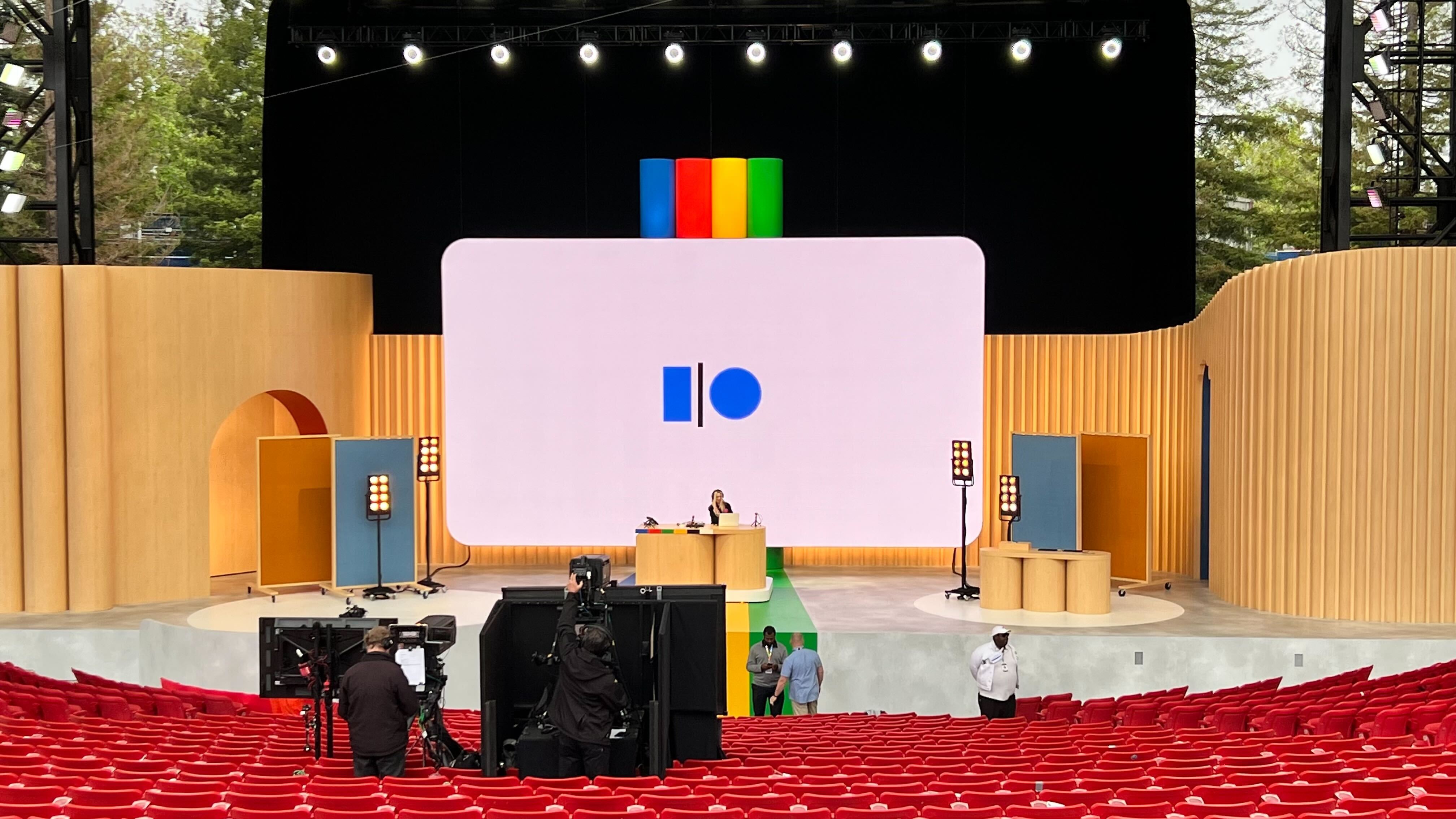
Google’s lead in photo magic (think magic eraser and unblur) is sure to continue with what we expect are some new photo tricks. No one has leaked anything significant, but the buzz is that we’re gonna be wowed.
Naturally, if some new photo tricks fail to materialize, we’ll be disappointed, but it seems almost certain that the entire Pixel phone line will have some new photo powers that, while they may only apply to the latest Pixel 7 and Pixel Fold, could work their way down the line. We do expect the rumored new 7a will have some of these skills, whatever they may be, as well.
Of course, we can’t wait to try out all of the Pixel-exclusive photo editing features on the first Pixel tablet. It’s fun fixing up old photos on a phone screen, but on a tablet we should really be able to get some serious photo work done.
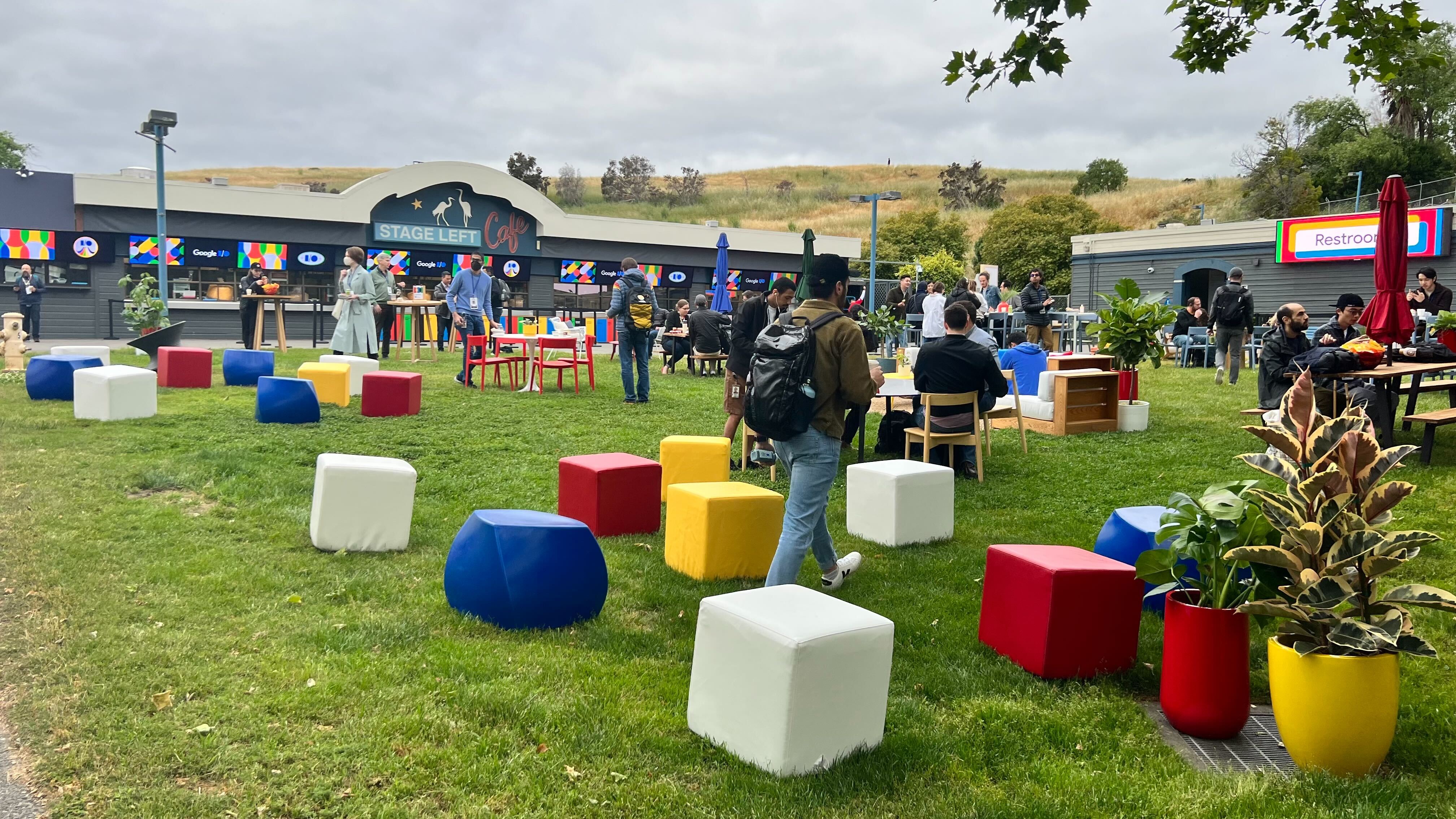
The most important tech launches of the year tend to happen in the last quarter, but the big California companies love to use the late Spring weather to highlight new products. This week it’s Google at I/O 2023. In one month, Apple will host a similar crowd just down the road at its Cupertino HQ. Both Mountain View and Cupertino are suburbs of San Jose, the third-largest city in California.
Our editors are lining up now to hear Google’s keynote address, where Google SVP of Devices and Services Rick Osterloh is expected to give us all the news.
We’re inside the Shoreline Amphitheater. #GoogleIO pic.twitter.com/DwzViiYf8WMay 10, 2023
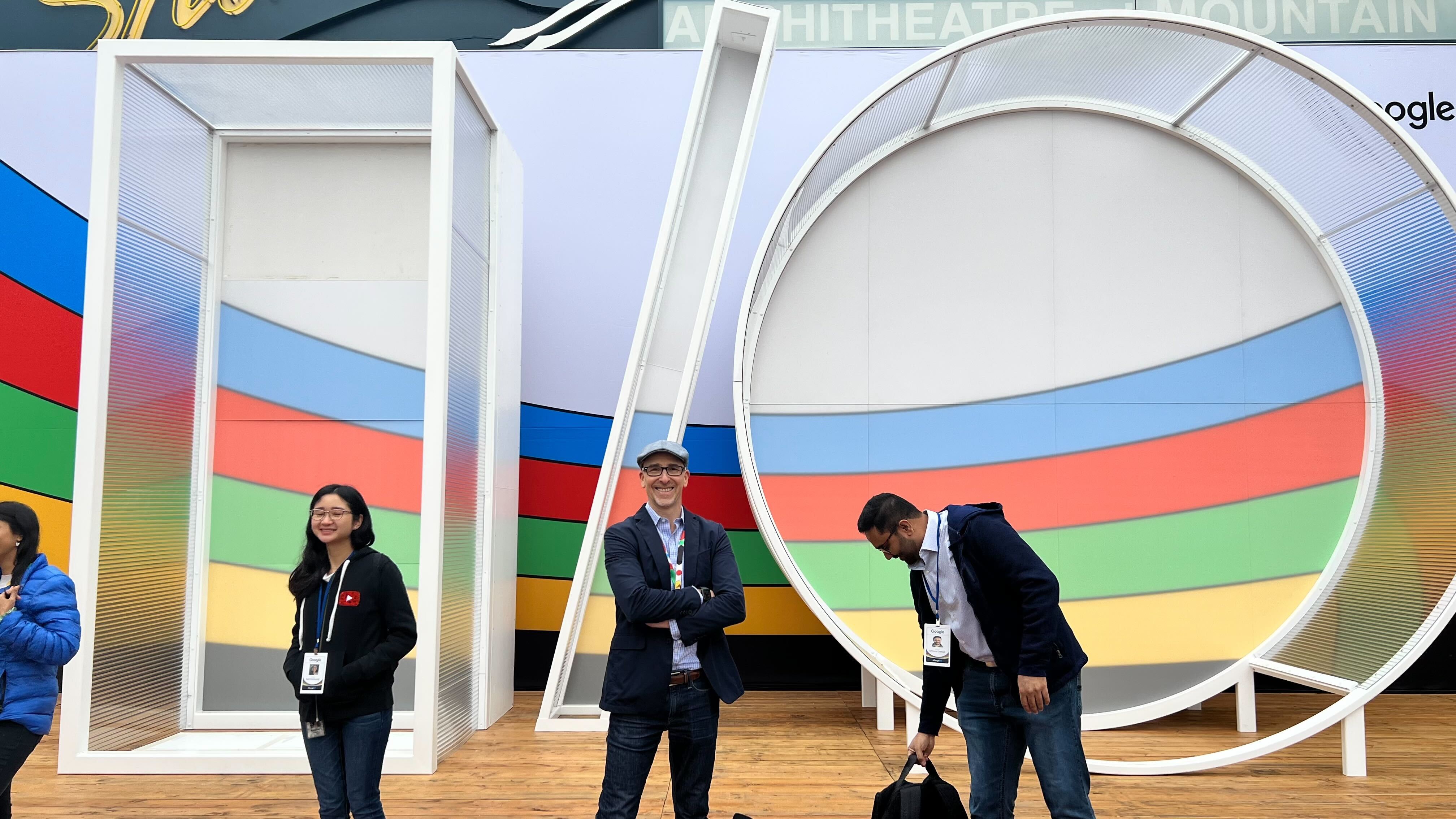
Do we know everything about Google I/O? Not even close (we hope). After all, what’s the fun of ruining all the surprises early? We know about the new phones and the Pixel Tablet, but what about the Pixel Watch 2? We haven’t heard much, so we’re guessing there will be a mention from the stage, but nothing to see on hand. We’d love to be wrong!
There are also plenty of software apps and features that Google could update, outside its most popular Android 14 and Bard developments. There could be additions to Google Maps, Android Auto, YouTube and content creation, or any number of Google channels. Google’s parent Alphabet has its fingers in so many pies, you never know what will stick.
We’ll have hands-on with the new products coming up soon, as soon as Google is done with its spiel. In the meantime, our E-i-C Lance Ulanoff is living it up in cloudy California. Sorry about the weather, Lance.
I’m here! Pay no attention to the stretched face on my badge. #GoogleIO pic.twitter.com/fgbSaEiYSUMay 10, 2023
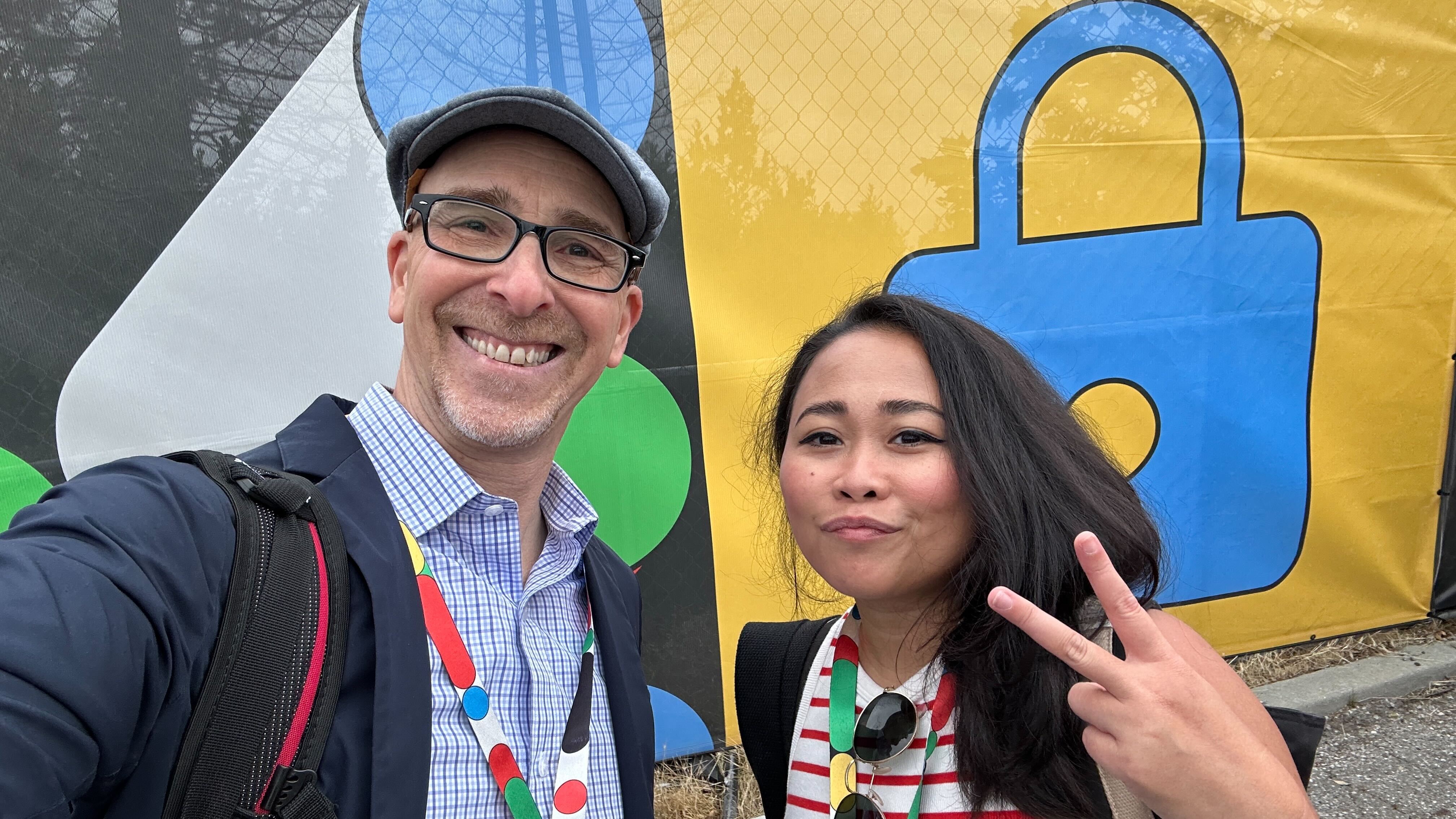
Get excited, folks! We’re now only two hours away from the start of Google I/O 2023. As a reminder, proceedings kick off at 10am PT / 1pm ET / 6pm BST (or at 3am AEST on Thursday, for those in Australia), and you’ll be able to watch along via the video link embedded at the top of this page.
TechRadar’s US Editor in Chief, Lance Ulanoff, is on the ground in California alongside Computing Reviews editor Michelle Rae Uy, and we’ve got teams on both sides of the Atlantic ready to bring you the latest from Google’s annual product showcase.
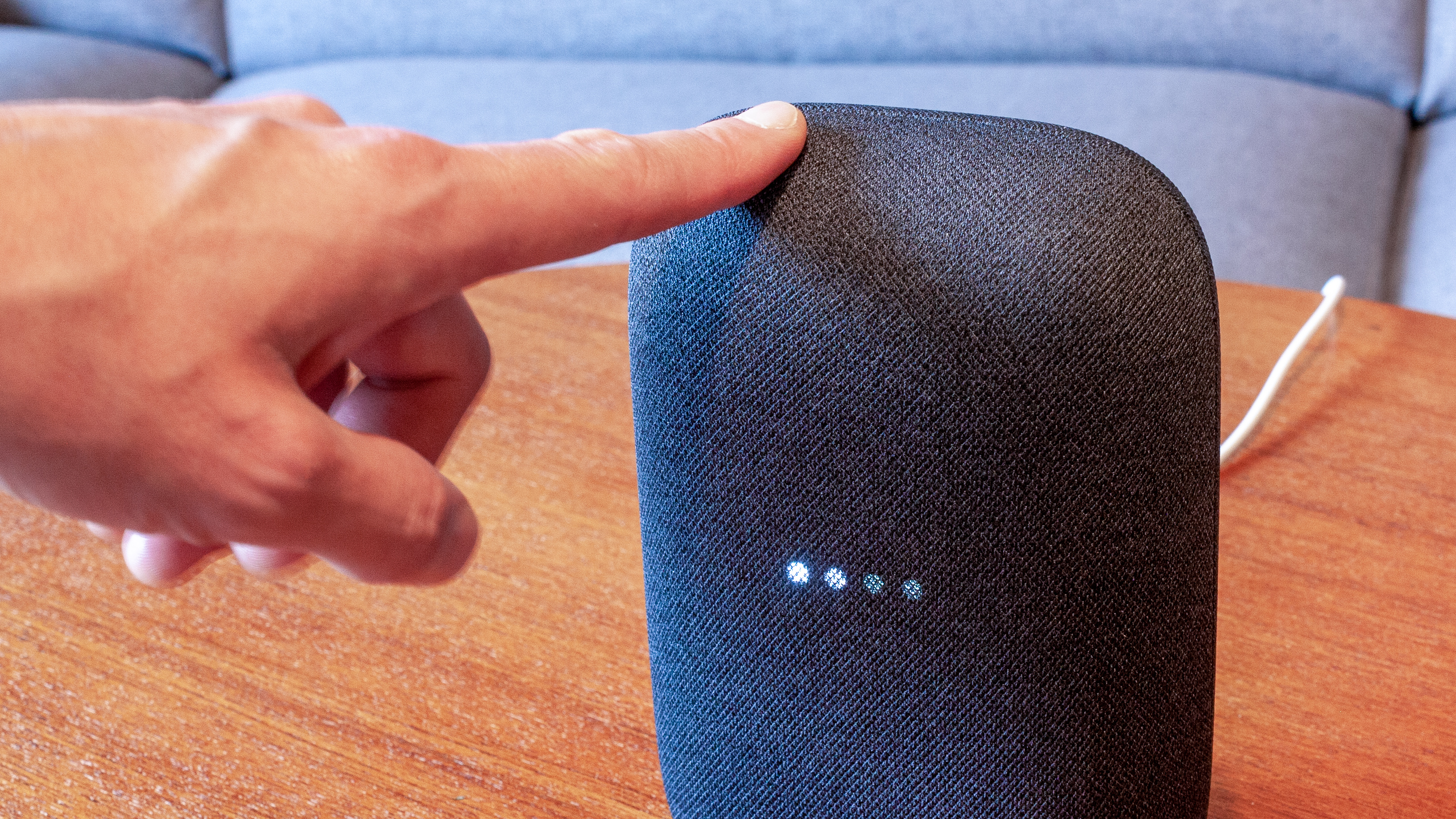
Much has been made of the phone-related announcements expected to come from this year’s Google I/O showcase, but things have been far quieter on the audio front. If Becky Scarrott, TechRadar’s Senior Audio Staff Writer, had her way, though, Google would unveil the Google Nest Audio Gen 2 at Google I/O 2023:
“The headline product reveal at I/O 2023 – in my dreams. I know I’m in the minority here (as woman in tech journalism, for starters) but I liked the inaugural September 2020 Nest Audio, a friendly cuboid that aimed to hold sound quality in even higher esteem than voice smarts. A noble aim; one I also aspire to.
It didn’t work out like that of course. A quick glance at our Google Nest Audio review reveals a speaker that excelled in smarts but missed the mark in terms of detail through the mids and trebles, also sounding harsh at higher volumes.
But come on Google, you’re giving up after one redesign? Surely not. That pebble-colored, fabric-swathed second-gen. speaker had promise! And not once was it ever mistaken for an air freshener in my home (yes Google Home, I’m looking at you) so look how far you came already! I say give it another shot – maybe look at the driver array and integration. You got this.”
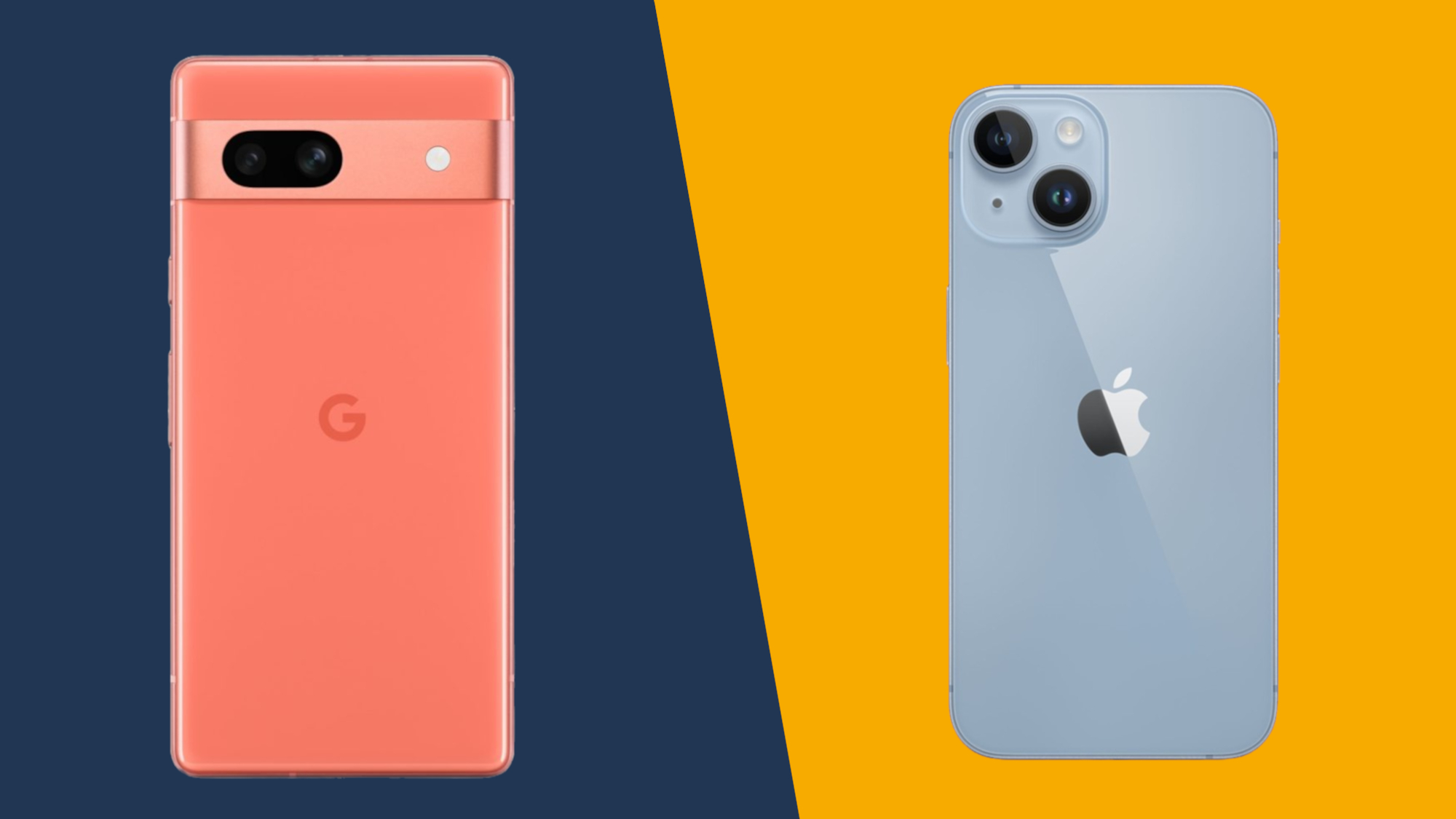
The Google Pixel 7a is expected to replace its predecessor, the Google Pixel 6a, as one of the best cheap phones to buy in 2023 – but the presumed affordability of Google’s next mid-ranger doesn’t mean it’ll skimp on features.
We trawled through the phone’s various leaked specs to examine the Google Pixel 7a vs iPhone 14, and the former handset could well challenge Apple’s latest vanilla iPhone in several important areas.
For instance, while the Google Pixel 7a looks likely to boast a similar 6.1-inch OLED display to the iPhone 14, rumors suggest it’ll actually sport a superior battery (4,410mAh vs 3,279mAh) and main camera (64MP vs 12MP). Your move, Apple.
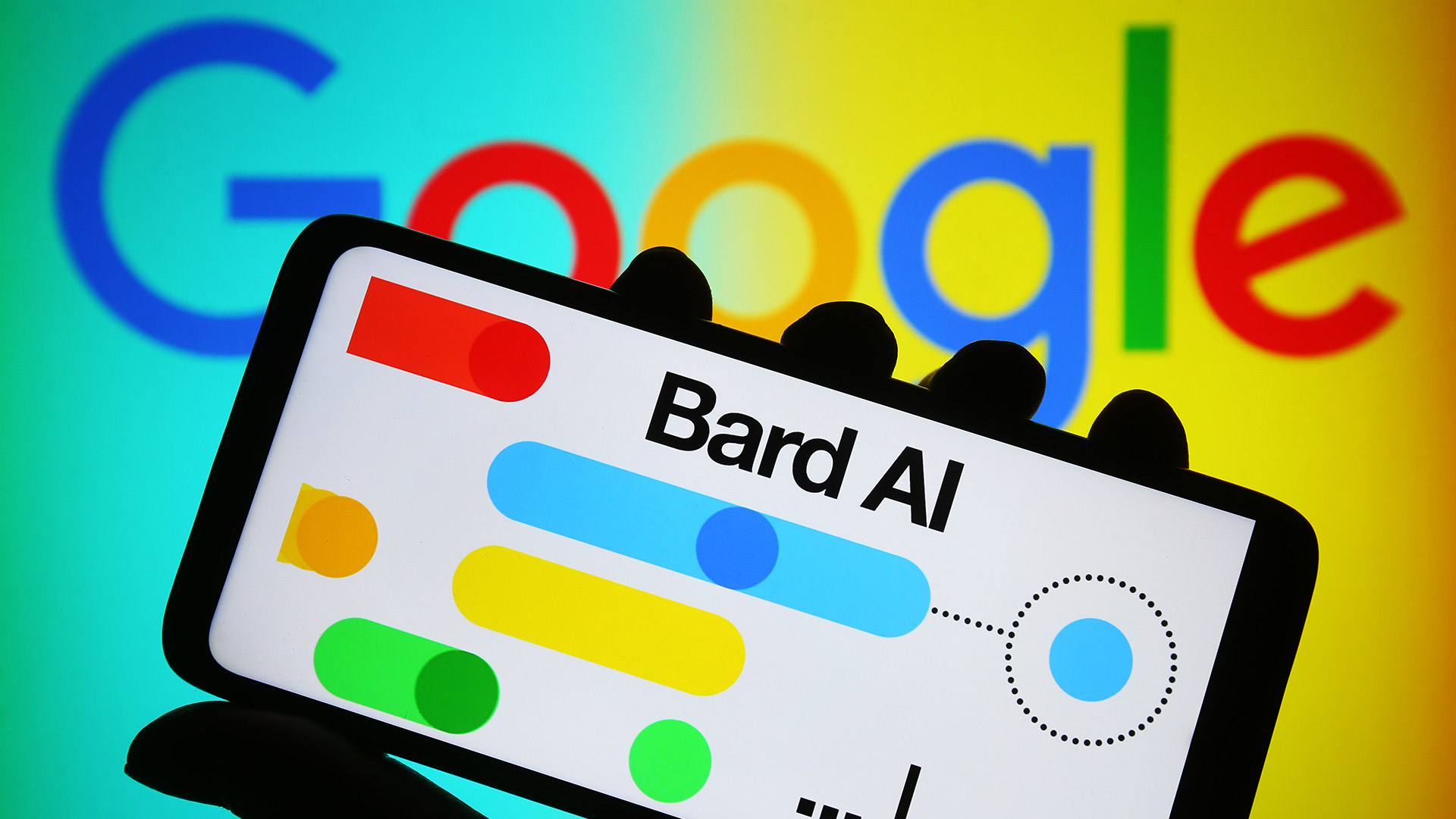
Google’s AI-powered chatbot, Bard, had this to say when TechRadar’s Computing Reviews editor, Michelle Rae Uy, asked what we what we should expect to see at this year’s Google I/O showcase:
“Here are some of the things you can expect to see at Google I/O 2023:
- New versions of Android, Chrome, and other Google products
- New hardware products, such as the Pixel Fold
- Updates to Google’s cloud computing services
- Announcements about Google’s AI and machine learning efforts
- Opportunities to learn from Google engineers and developers”
And for the updates expected to come to Chrome, specifically, Bard said…
- “First, we can expect to see further improvements to Chrome’s performance and security. Chrome is already one of the fastest and most secure browsers available, but Google is always working to make it even better.
- Second, we can expect to see new features that make Chrome more user-friendly. For example, Google may announce a new feature that makes it easier to find and install extensions.
- Third, we can expect to see new features that make Chrome more accessible to people with disabilities. For example, Google may announce a new feature that makes it easier to use Chrome with a screen reader.
- Finally, we can expect to see new features that make Chrome more integrated with other Google products. For example, Google may announce a new feature that makes it easier to share links between Chrome and Gmail.”
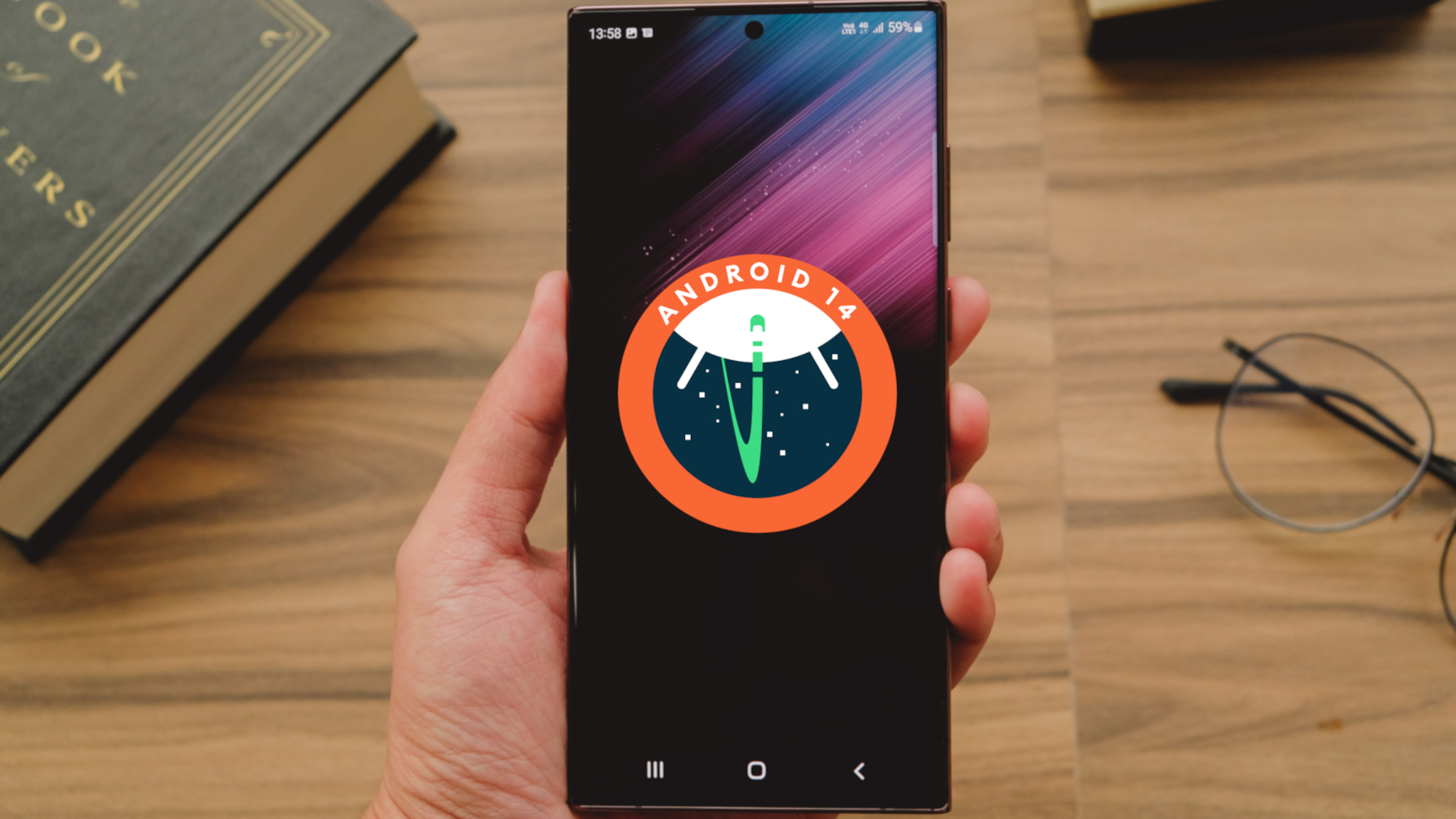
And now let’s touch on the power behind these devices – Android 14. Though none of them will run Android 14 at launch, all three new devices will be eligible for a day one update, as will current Pixels going all the way back to the Pixel 4a 5G and Pixel 5.
Google typically doesn’t let us know the big Android changes till IO, though developer and public beta releases have already given us a slight peek at what to expect. Other than improvements for tablets and foldables, Google says that multi-device experiences are going to be a big part of Android 14.
Are we going to see Apple-style cross-device features make their way to Android at long last? With Nearby Share coming to Windows and ChromeOS, Google’s already built some semblance of Apple-like integration. Now, with a near complete hardware slate (RIP Pixelbook), the company has a chance of making it work.
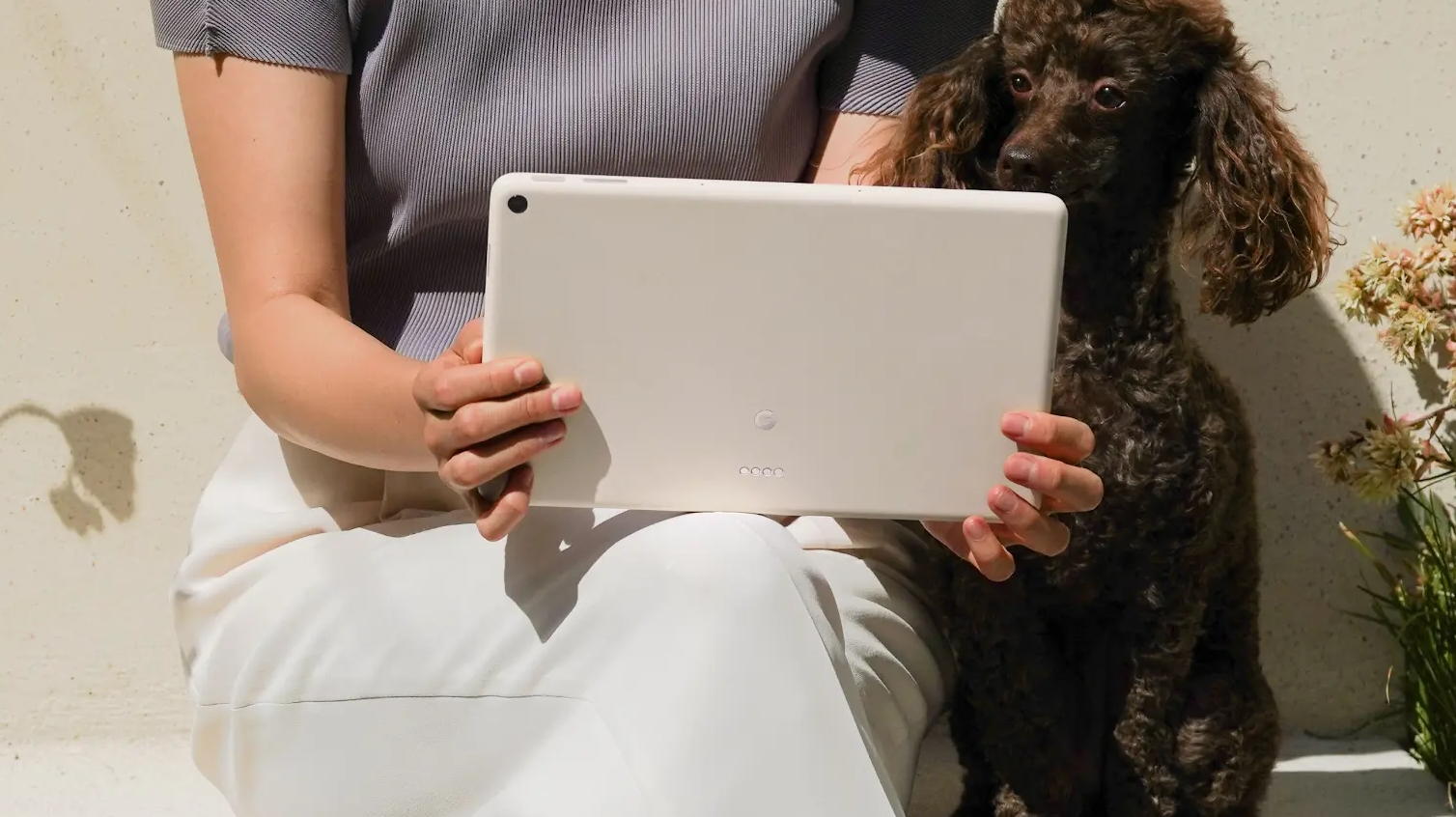
Let’s not forget the Pixel Tablet. Google’s third Pixel tablet had already been announced at last year’s Google IO, and now it’s likely to be made available for pre-order shortly after this event if our instincts are right.
Google is no stranger to tablets; the Pixel C preceded Pixel phones and the Pixel Slate was a well-built one. Google’s tablet ambitions were neutered by poor software in both instances, and that’s an area where the Pixel Tablet will hopefully do better.
The company has promised us a treat with Material You’s customization, Android 13, and the new Tensor G2 processor to keep it all flying.
Going back to Android 13, Google has done a lot of work to make its Android look good on large screens. Areas like the home screen, the lock screen, and the notification center now work better on tablets. Beyond that surface level, the company has even updated several of its apps (opens in new tab) from Google Photos to Google TV to take advantage of the large-screen canvas you’ll be getting. With Android 14, Google plans to improve that, though how exactly, we’ll have to wait to find out.
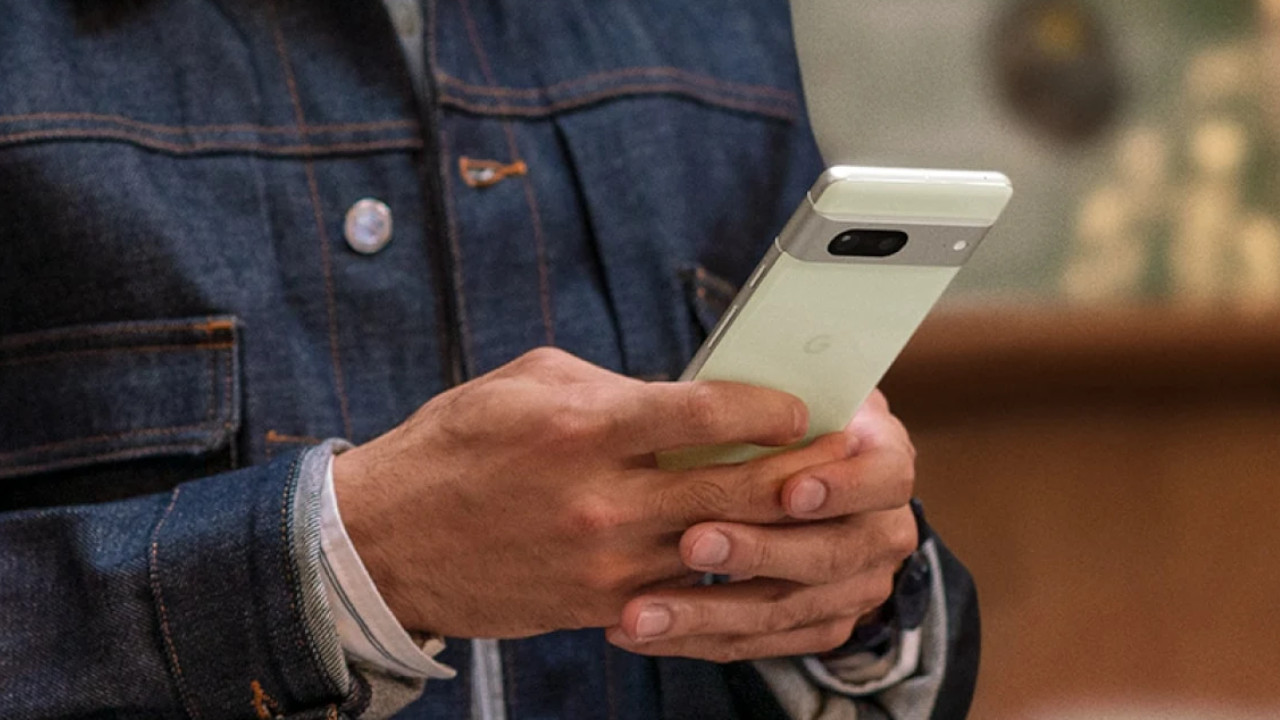
Another one of the gadgets we expect to see at Google I/O is the Google Pixel 7a, the next entry in Google’s more budget-friendly line of smartphones. According to leakers who have got their hands on the device early it’ll have a 6.1-inch OLED display, a 64MP main camera, and is powered by Google’s Tensor G2 chip.
If that sounds pretty exciting to you and you can’t wait to pick up Google’s next smartphone for yourself then you might be in luck. Several people are seemingly selling the Pixel 7a early on the US Marketplace platform Swappa (opens in new tab), though you might want to wait.
That’s because the cheapest listing price for the Google Pixel 7a at the time of writing is $460, slightly more expensive than the $449 we expect the device to sell for in the US. In the UK and Australia, we expect the handset to cost £399 / AU$749 respectively, but we’ll have to wait and see what Google announces at I/O later today.
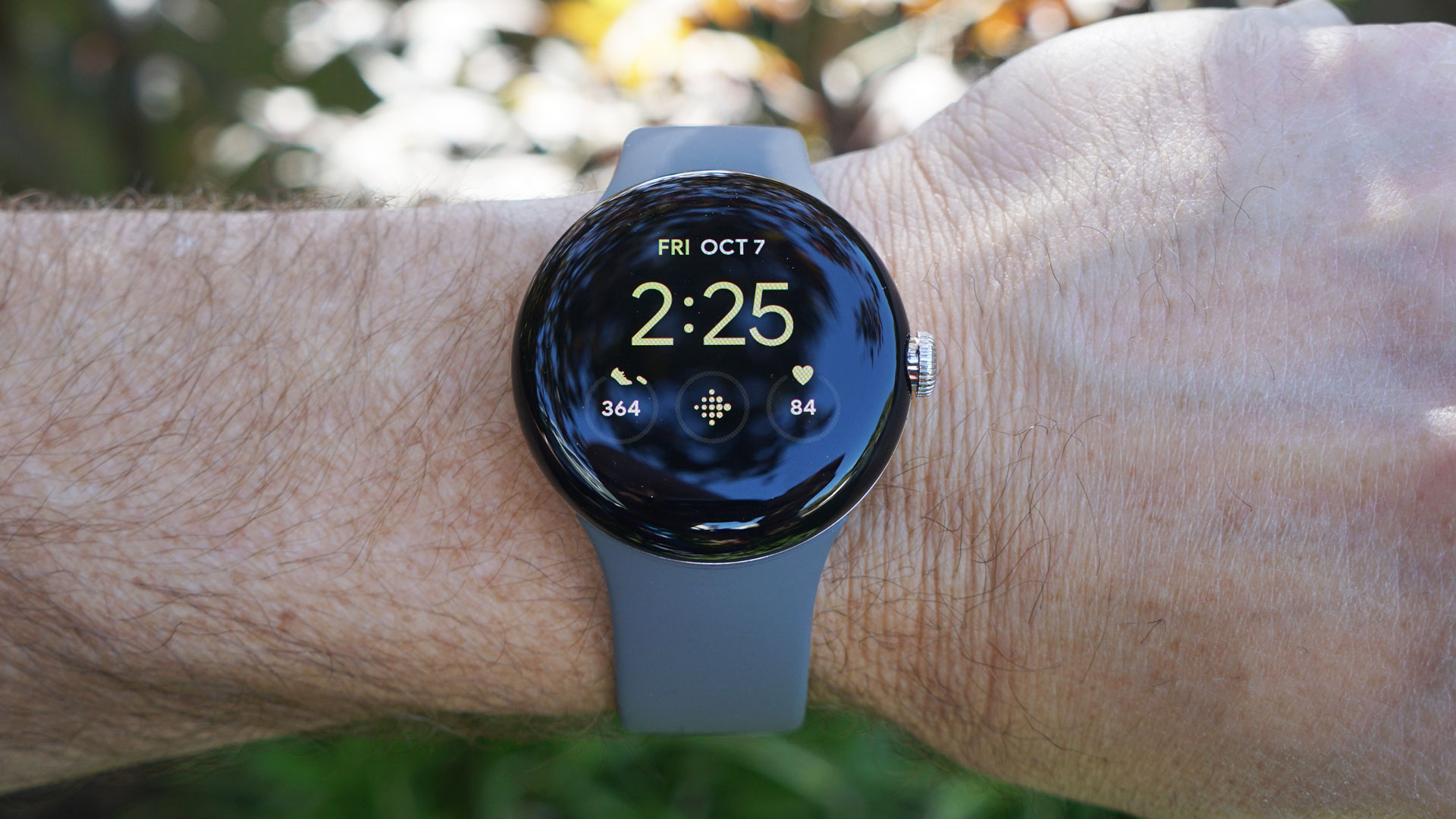
As well as all the exciting Pixel Fold and Pixelbook goodies being unveiled during I/O, don’t forget about the next iteration of Google’s Pixel Watch.
The rumor mill has been quiet on this for a long time. Since the first Google Pixel Watch launched last year, weren’t sure if a Pixel Watch 2 announcement was coming during Google I/O, or even if one would arrive at all this year. Would the Pixel Watch follow in the Apple Watch’s footsteps with an annual release, or would it share more than software with Fitbit and bring out new models only every few years?
Now I/O is here, it’s looking likely the Pixel Watch 2 will be revealed during the keynote. Leaker Evan Blass tweeted the name “Pixel Watch 2” recently, hinting that at least an announcement, if not a full demonstration, is imminent. Last year, Google teased the Pixel Watch months before its full October release date, and we’re betting the sequel will follow a similar pattern.
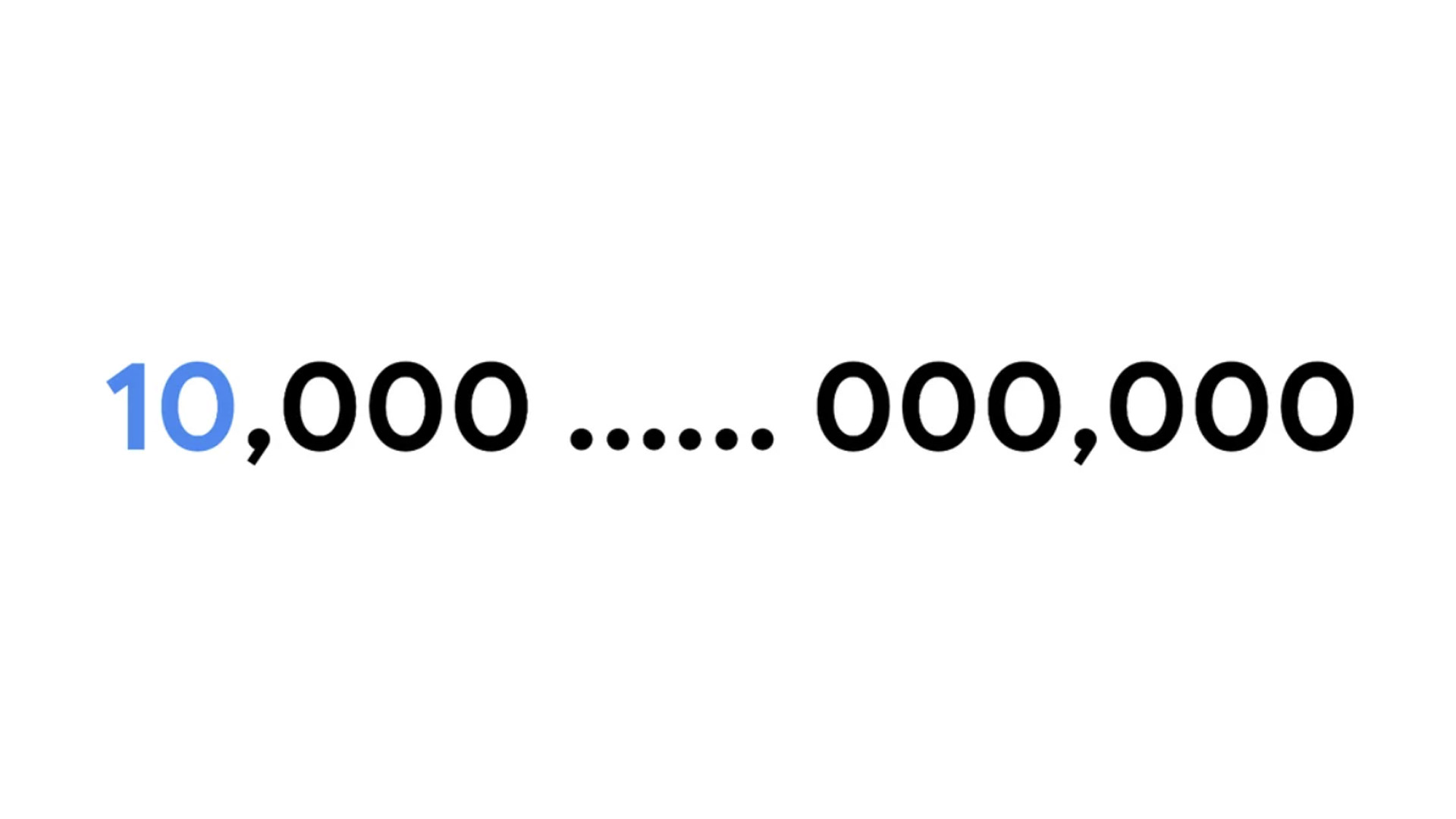
Ever wondered what the ‘I/O’ bit in ‘Google I/O’ stands for? Google has helpfully answered that very question this morning, posting a blog entry (opens in new tab) where it explains how the event got its name.
The post is a long and interesting dive into the history of Google I/O, which celebrates its 15th birthday this year. I recommend reading the whole thing if you have an interest in all things Google, but the short answer is that I/O is actually 1/0: the characters are supposed to be the first two digits in a googol, the number that gave the company its name. So there you go!
Sticking with Google’s first foldable phone, a last-minute Google Pixel Fold teaser video has shown it off in full.
The video – which we’ve included above, assuming Google hasn’t removed it yet – shows the phone being used by various NBA stars. It’s not clear whether Google meant to share it ahead of I/O, but it’s out in the wild now anyway!
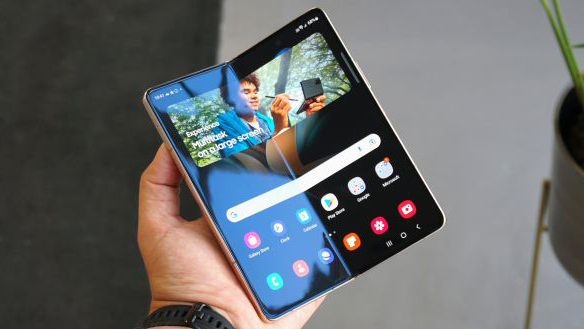
Among the reasons to be cheerful about the Pixel Fold are the fact that it’s rumored to have a bigger battery than the Samsung Galaxy Z Fold 4. We don’t yet know exactly how big it will be, of course, but it’s been tipped to have a capacity of between 4,500mAh and 5,000mAh. The Galaxy Z Fold 4 (pictured), in contrast, has only a 4,400mAh cell.
A bigger battery doesn’t always equal better battery life – the size of the screen, efficiency of the processor and lots of other factors can influence that – but it’s a good start. And given that Google is apparently pitching the Fold as having “Beyond 24-hour battery life”, we’re optimistic about this one.
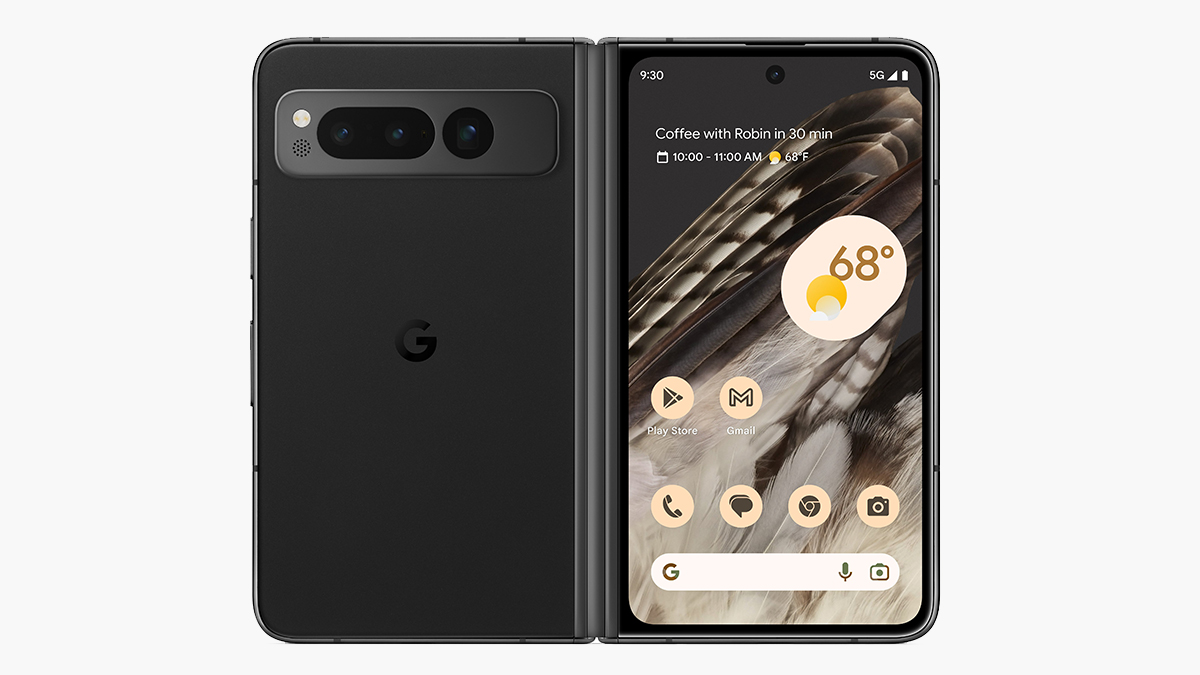
So, what’s the device that we’re most excited about (hopefully) getting a big reveal later today? Personally, it would be the Google Pixel Fold. We know this will definitely feature at I/O 2023, after Google itself teased the Fold on Star Wars Day. And we also think we know quite a bit about the device after months of rumors and leaks.
The biggest of these came from Jon Prosser of FrontPageTech a few weeks ago. He released a seven-minute video teasing full details about the Pixel Fold, and if the details he shared are accurate then there’s reason to be very excited indeed.
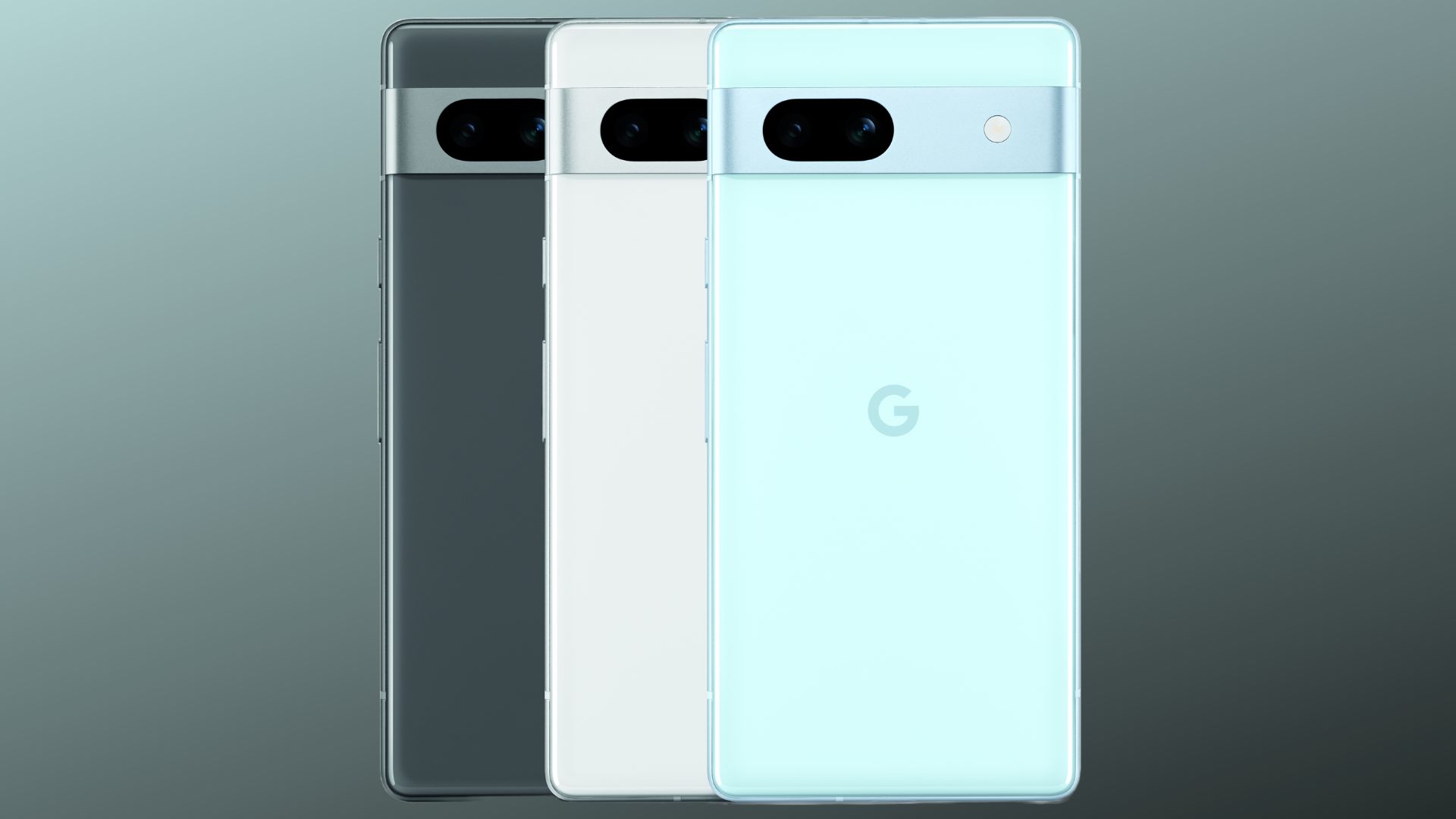
While we wait for the festivities to begin, we can satisfy ourselves with this tasty Google I/O 2023 primer. It covers all the big announcements we’re expecting, including the Pixel Fold, Pixel Tablet, and what could be a very popular Pixel 7a. It’s easily the most anticipated mid-range Android phone of the season.
While the Bard updates and Pixel Watch 2 might be speculative, Android 14 is a lock as one of the stars of the development show. We do wonder, though, if Google can do enough to make Android cool again.
Good morning, and welcome to our Google I/O 2023 live blog. Marc McLaren here in the UK to get this show on the road. The action gets under way at 10am PT / 1pm ET / 6pm BST today, which means we have plenty of time to discuss everything that we expect to see later today.
Keep this page bookmarked for all the last-minute rumors and news ahead of the keynote, then stick with us once the event gets going for all the big reveals as they happen.
Services Marketplace – Listings, Bookings & Reviews